Birds in the sea have always piqued the curiosity of humans, with their unique characteristics and adaptations allowing them to thrive in marine environments.
Coastal regions around the world are home to a diverse range of bird species that rely on the ocean’s resources for their survival, feeding on fish, krill, and other marine life.
These majestic creatures have adapted to the harsh and ever-changing environments of the sea, developing remarkable physical features such as waterproof feathers and powerful wings for effortless flight over the waves.
From elegant albatrosses to swift terns, the world of seabirds is teeming with beauty and wonder.
In this article, we will explore some of the fascinating aspects of birds in the sea, uncovering their behaviors, adaptations, and their importance in the marine ecosystem.
1. Gulls
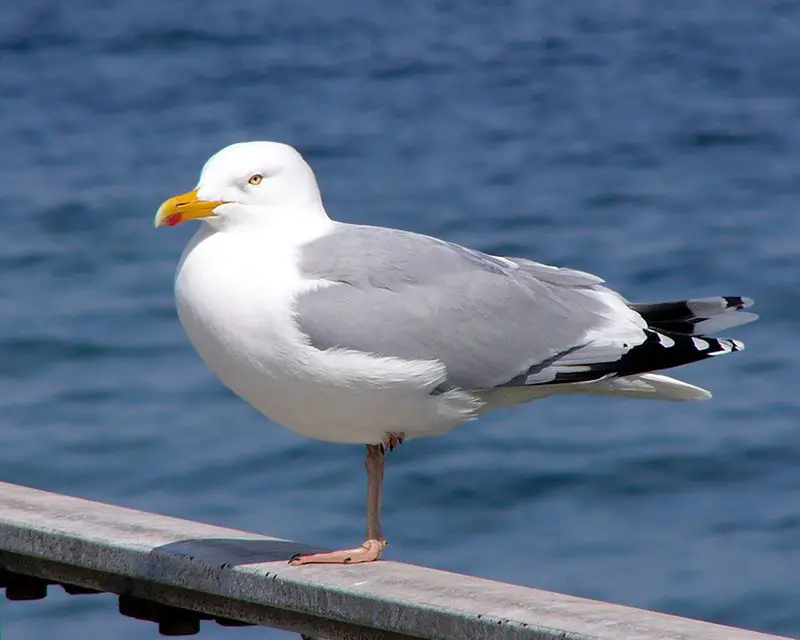
Gulls are a type of seabird in the family Laridae found worldwide. They are highly adaptable, often seen soaring above shorelines or near bodies of water.
Gulls have strong wings and long bills and vary greatly in size, colouration and behaviour from one species to another.
Some gull species feed on fish while others scavenge for food such as insects, small mammals or discarded human refuse.
Despite their different dietary habits they all share common traits including webbed feet which enable them to swim gracefully through the water after prey items like crabs or molluscs.
Gulls generally nest close to the shoreline where there is an abundance of available food sources making them excellent hunters that can live comfortably both on land and at sea.Scientific classification:
| Kingdom | Animalia |
| Phylum | Chordata |
| Class | Aves |
| Order | Charadriiformes |
| Suborder | Lari |
| Family | Laridae Rafinesque, 1815 |
Also Featured In: Most Common Birds in China, Birds of Sweden
2. Petrels
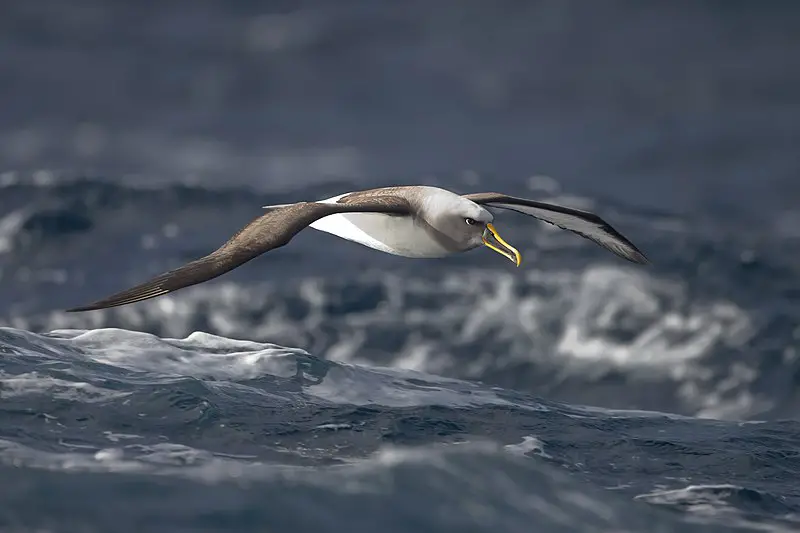
Petrels are seabirds that belong to the Procellariiformes order. They come from four families: albatrosses, petrels and shearwaters, as well as two storm petrel families.
Commonly referred to collectively as ‘petrels’, these birds have a long history of being called Tubinares or tubenoses – referring to their distinctive beaks which feature small tubes on either side for them to detect food in dark seawater.
Petrels mainly consume fish, squid and other small marine creatures, but they also feed off carrion when needed.
These waterbirds can fly great distances over open oceans in search of food with no land insight.Scientific classification:
| Kingdom | Animalia |
| Phylum | Chordata |
| Class | Aves |
| Clade | Austrodyptornithes |
| Order | Procellariiformes Fürbringer, 1888 |
Also Featured In: Beautiful Brazilian Birds, Birds that Can Survive in the Storm
3. Northern Storm Petrels
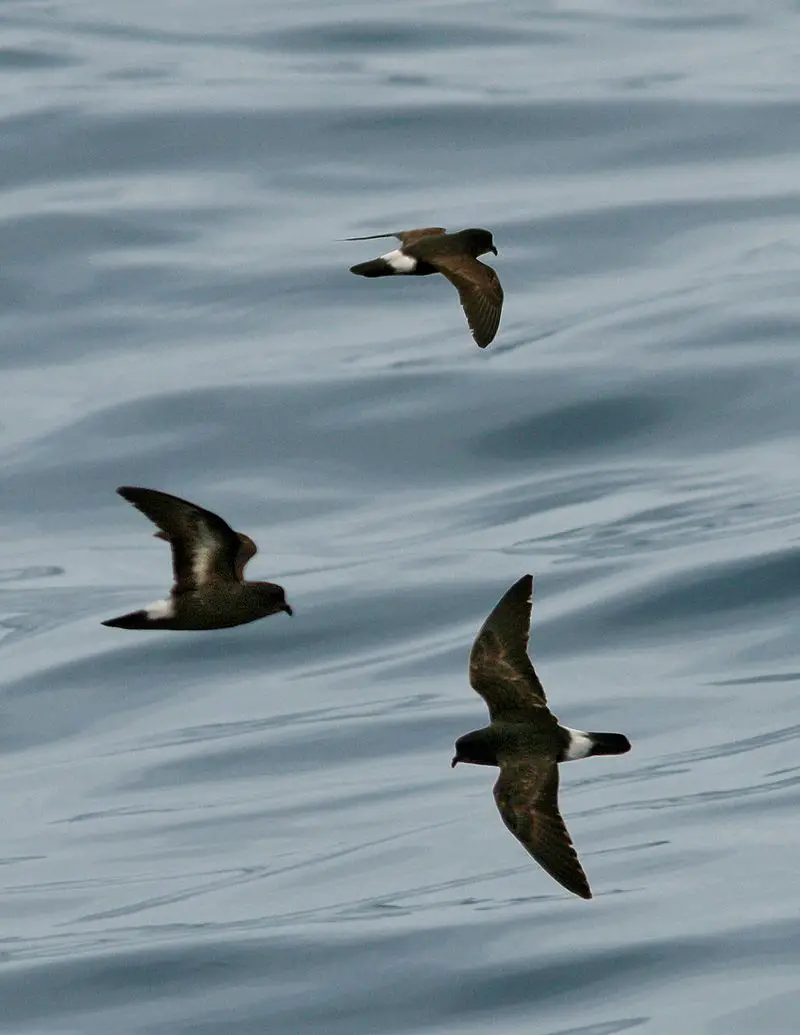
Northern storm petrels are one of the smallest seabirds, inhabiting oceans all over the world.
They have a unique ability to hover over water and pick planktonic crustaceans and small fish from the surface.
Northern storm petrels belong to the genus Hydrobates in family Hydrobatidae, part of Procellariiformes order.
This species was once lumped with austral storm petrel but recent studies show that they weren’t related closely which led them being split into two distinct species now.
These birds can be identified by their dark grey upperparts and wings along with white underparts when seen from afar while feeding on ocean’s surface.Scientific classification:
| Kingdom | Animalia |
| Phylum | Chordata |
| Class | Aves |
| Order | Procellariiformes |
| Family | Hydrobatidae Mathews, 1912 |
| Genus | Hydrobates F. Boie, 1822 |
Also Featured In: Lebanon Birds Live in Semi-Desert Areas, Common Denmark Birds
4. Sanderling
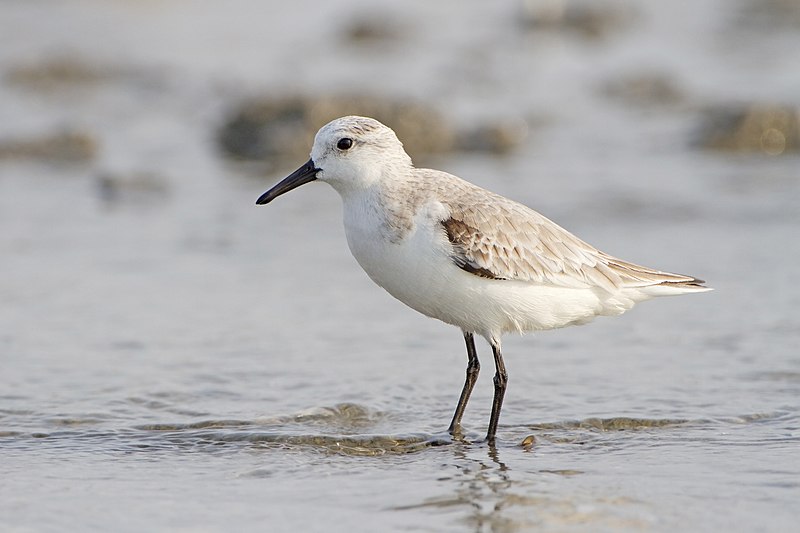
The Sanderling is a small wading bird that can be found in the Arctic region. Its name comes from Old English, meaning “sand-ploughman”. It has grey feathers and light legs which give it its distinct white coloration.
During summer breeding months, they are known to travel great distances – some wintering as far south as South America or Southern Africa. They typically feed on crustaceans such as shrimp and mollusks along coastal shores.
The Sanderling is an important species to watch out for because of their long migratory patterns and sensitivity to environmental change; if there’s trouble with this species then other birds may also be affected.Scientific classification:
| Kingdom | Animalia |
| Phylum | Chordata |
| Class | Aves |
| Order | Charadriiformes |
| Family | Scolopacidae |
| Genus | Calidris |
| Species | C. alba |
Also Featured In: Top Birds Found in Mexico, Birds that can be Seen in Outer Banks
5. Magnificent Frigatebird
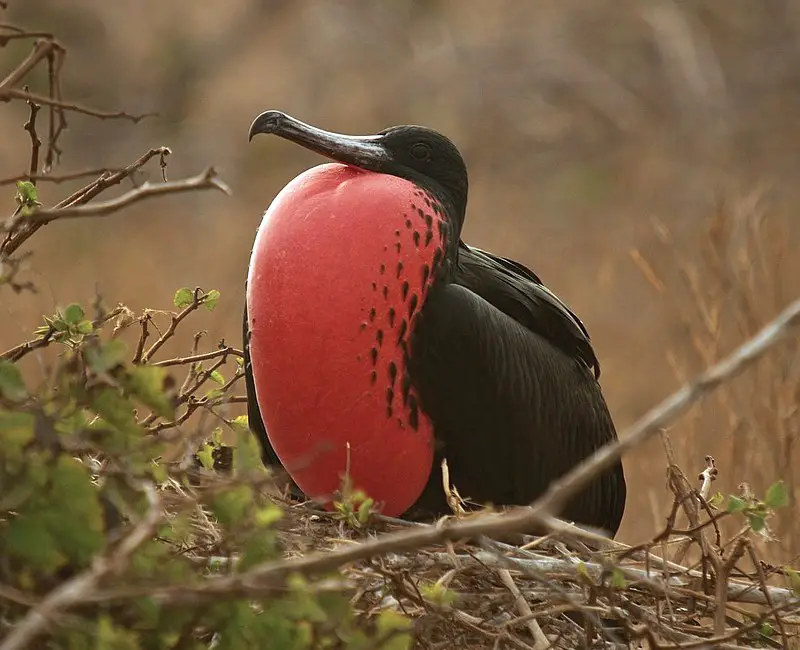
The Magnificent Frigatebird is the largest species of frigatebird, measuring between 89 and 114 cm in length and having a wingspan of 7-8 ft.
It can be found over tropical waters off America from northern Mexico to Peru on the Pacific coast, as well as Florida down south.
Its diet consists mainly of fish they take from other seabirds or snatch directly from the ocean surface while flying low above it.
They also feed on crustaceans and squid when available too.
This impressive bird has an unmistakable silhouette with its long pointed wings, forked tail feathers and male’s red gular pouch which inflates during courtship displays.Scientific classification:
| Kingdom | Animalia |
| Phylum | Chordata |
| Class | Aves |
| Order | Suliformes |
| Family | Fregatidae |
| Genus | Fregata |
| Species | F. magnificens |
Also Featured In: Most Common Birds in South America Birds, Caribbean Birds
6. Sulids
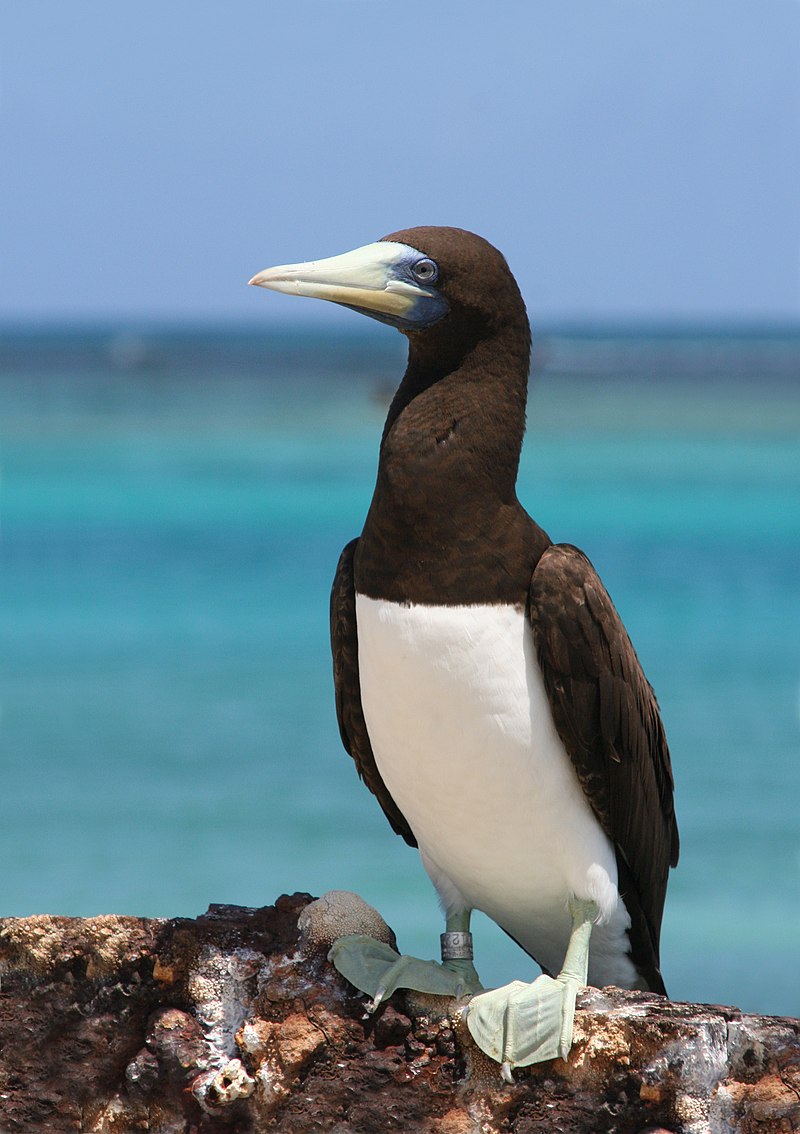
Sulids are a medium-large family of coastal seabirds that includes both gannets and boobies. They hunt by diving into the water to catch their prey, such as fish, squid or crustaceans.
These birds have long wings which they use to soar gracefully while searching for food. Sulids also possess webbed feet and strong beaks designed for snatching up prey from below the surface of the sea.
Members of this family vary in size; some species can grow over 3ft tall with a wingspan reaching 5 ft. The 10 different species all belong either to Sula (boobies) or Morus (gannets).
It’s easy to tell them apart due to differences in colouration, behaviour and DNA sequences between each type.
In summary, sulids are impressive hunters who plunge dive after food at sea but still manage remain graceful aviators despite their large size.Scientific classification:
| Kingdom | Animalia |
| Phylum | Chordata |
| Class | Aves |
| Order | Suliformes |
| Family | Sulidae Reichenbach, 1849 |
Also Featured In: Egyptian Birds, Birds that Live in Croatia
7. Brown Booby
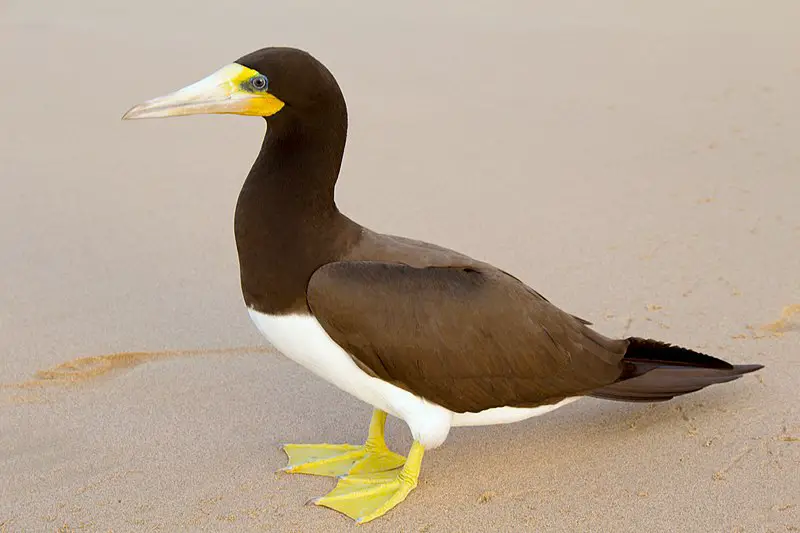
The Brown Booby is a large, seabird from the booby family Sulidae. It has a pantropical range and can be found in many areas of the world.
This bird lives in flocks and forages by plunging into shallow waters to catch small fish that are driven near the surface by predators or storms.
The brown booby is known for its short wings which make it highly maneuverable when hunting; this allows it to pursue prey quickly with sudden turns and dives.
Its diet also includes squid, crustaceans, eggs of other birds, as well as scraps from boats or ships they may come across while flying around coastlines.
They sometimes rest on floating objects during their long flights over open water between islands or continents.Scientific classification:
| Kingdom | Animalia |
| Phylum | Chordata |
| Class | Aves |
| Order | Suliformes |
| Family | Sulidae |
| Genus | Sula |
| Species | S. leucogaster |
Also Featured In: Birds that You’ll Find in Puerto Rico, Brown Birds of Florida
8. Black Guillemot
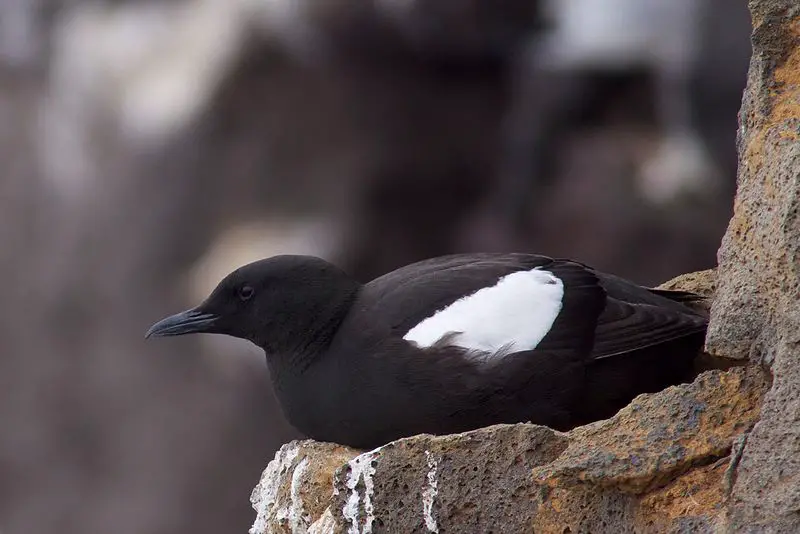
The Black Guillemot is a striking seabird found throughout the northern Atlantic coasts and eastern North American coasts. It has black feathers with white underparts, a red bill, and bright yellow feet.
They live around rocky shores, cliffs, and islands in single or small groups.
During winter months they migrate southwards from their high arctic breeding grounds to search for food sources such as fish eggs or invertebrates like shrimp that can be caught near shorelines.
Their diet also includes seeds and berries during summertime when they are nesting on coastal ledges creating burrows where they lay up to four pastel-colored eggs at once.
These amazing birds are very efficient swimmers using both their wings and webbed feet to propel themselves through water quickly while hunting prey.Scientific classification:
| Kingdom | Animalia |
| Phylum | Chordata |
| Class | Aves |
| Order | Charadriiformes |
| Family | Alcidae |
| Genus | Cepphus |
| Species | C. grylle |
Also Featured In: Birds of United Kingdom, Birds that Live in Greenland
9. Cormorants
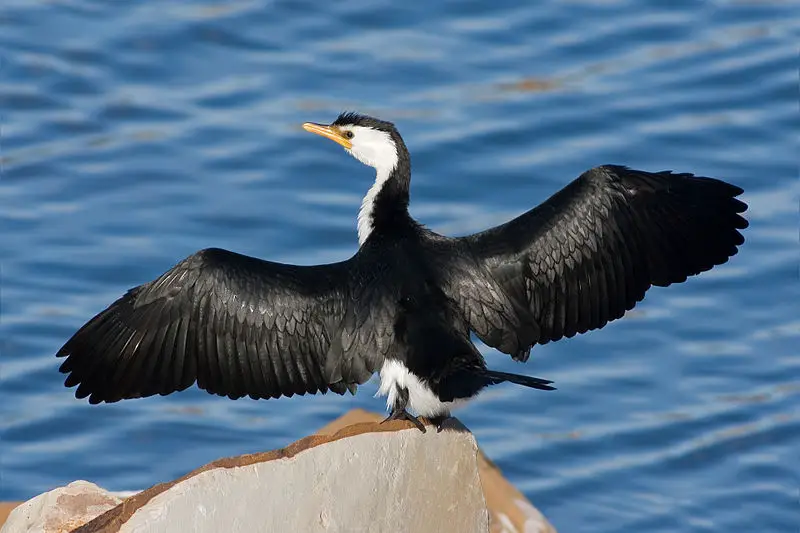
Cormorants are a family of aquatic birds found around the world. They include 40 species, such as great cormorants and common shags.
In Britain, these two species are the most commonly seen in their natural habitats.
Cormorants have long necks, webbed feet and can be identified by their glossy black feathers which they use to help them swim through water with ease as they hunt for food like fish or crustaceans.
They have an impressive wingspan often reaching up to five feet across when fully extended.
Despite being strong swimmers, these birds also enjoy spending time perched on rocks near rivers or shorelines where they will preen themselves in order to keep clean and dry during cooler weather conditionsScientific classification:
| Kingdom | Animalia |
| Phylum | Chordata |
| Class | Aves |
| Order | Suliformes |
| Family | Phalacrocoracidae Reichenbach, 1850 |
Also Featured In: Most common Birds in France, Flocks Birds around Us
10. Procellariidae
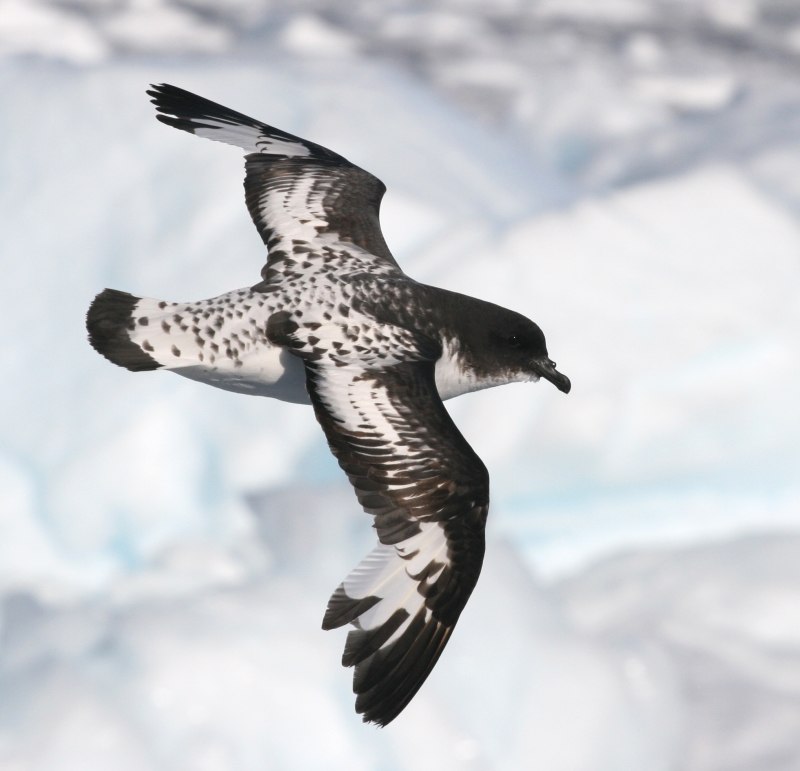
Procellariidae is a diverse family of seabirds belonging to the bird order Procellariiformes.
These birds are commonly referred to as tubenoses and include fulmarine petrels, gadfly petrels, diving petrels, prions, and shearwaters.
They range in size from the small storm-petrel which measures around 18cm long to the giant albatross which can reach up to 3 meters in length.
Generally found near oceans or coasts where they feed on fish as well as squid and other marine life depending on species.
Many procellariids will also nest inland during breeding season before returning back out at sea for most of their lives.
Their wings have specially adapted feathers that give them incredible gliding abilities allowing them literally fly with minimal effort over vast distances across oceanic regionsScientific classification:
| Kingdom | Animalia |
| Phylum | Chordata |
| Class | Aves |
| Order | Procellariiformes |
| Family | Procellariidae Leach, 1820 |
Also Featured In: Most Common Romanian Birds, Bulgarian Birds
11. Pelagic Cormorant
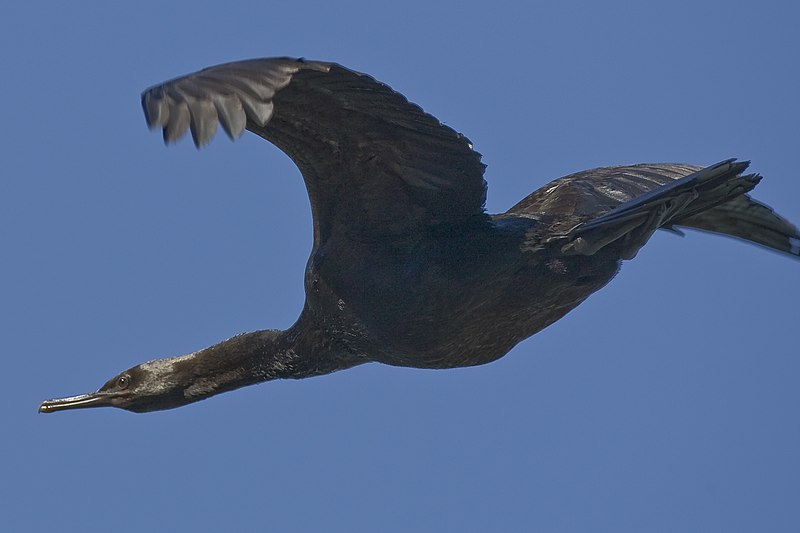
The pelagic cormorant, also known as Baird’s cormorant or violet-green cormorant, is a small member of the Phalacrocoracidae family and is often referred to as the Pelagic Shag.
It inhabits coastal areas and open oceans throughout Northern Pacific regions. These birds are relatively small in size with a dark greyish body and bright blue eyes which can be seen from far away distances.
Their wingspan extends up to two feet wide allowing them to glide through air currents at rapid speeds while they hunt fish for food.
They have an impressive diving ability that allows them to plunge underwater depths reaching 30 meters deep.
The pelagic cormorants are quite social creatures who live together in large flocks during both summer and winter months providing safety in numbers when hunting prey beneath the waves of their ocean home.Scientific classification:
| Kingdom | Animalia |
| Phylum | Chordata |
| Class | Aves |
| Order | Suliformes |
| Family | Phalacrocoracidae |
| Genus | Urile |
| Species | U. pelagicus |
Also Featured In: Native South Korean Birds, Birds that Live in Vancouver
12. Auk
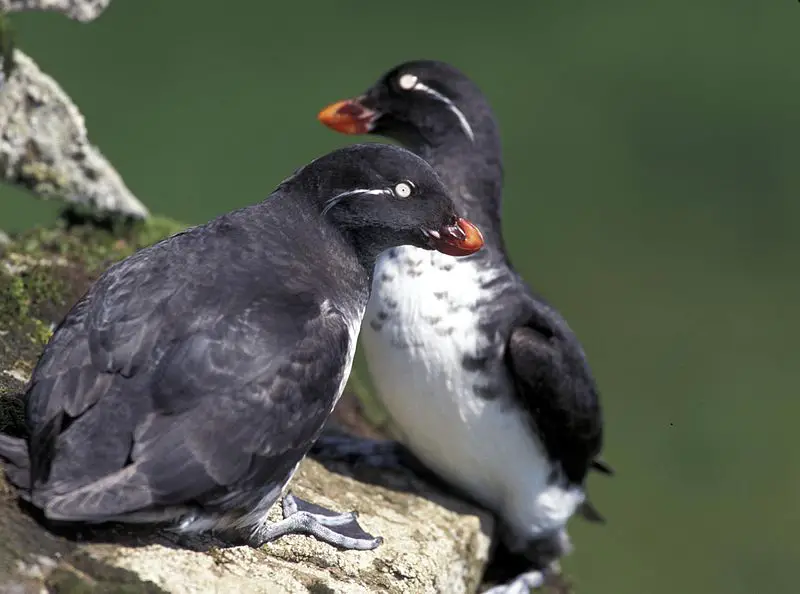
Auk is a family of birds from the order Charadriiformes. They are excellent swimmers and divers, able to “fly” through water. There are 25 species divided into 11 genera in this family, with the great auk being extinct.
Auks can fly but their walking appears awkward due to their thick feathers that make them heavy on land.
The most notable feature of these aquatic birds is the large bills they possess which helps them catch fish underwater.
Apart from feeding on sea creatures like squid or shrimp, auks also feed on grains found near shorelines during winter months when food sources become scarce in open waters.Scientific classification:
| Kingdom | Animalia |
| Phylum | Chordata |
| Class | Aves |
| Order | Charadriiformes |
| Suborder | Lari |
| Family | Alcidae Leach, 1820 |
Also Featured In: Common Birds in Canada, Italian Birds You Should Know
13. Atlantic Puffin
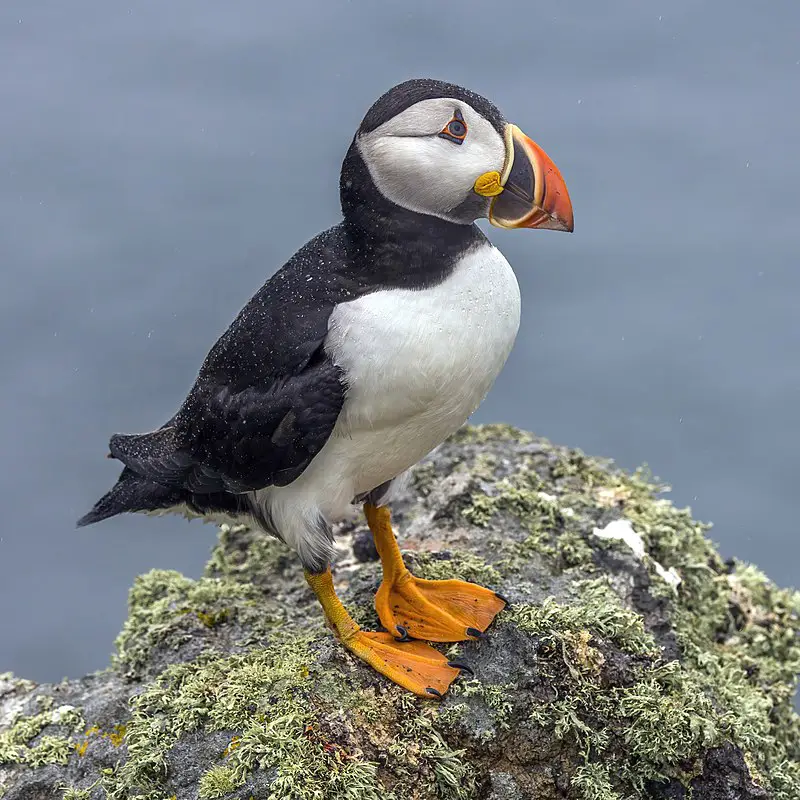
The Atlantic puffin is a seabird that belongs to the auk family. It has two related species found in the northeastern Pacific, namely tufted and horned puffins.
This bird breeds widely throughout Russia, Iceland, Ireland, Norway, Greenland and Canada’s Newfoundland & Labrador as well as Nova Scotia regions of Faroe Islands.
Its colorful beak with markings of yellowish-orange during mating season makes it stand out among other birds.
An interesting fact about this sea-dweller is its ability to fly underwater; they use their wings for propulsion while swimming.
The Atlantic puffin diet consists mainly of fish caught from shallow waters near shorelines or cliffsides where they nest annually during springtime months before embarking on long migrations southward towards winter grounds at seaside coasts until spring returns once again.Scientific classification:
| Kingdom | Animalia |
| Phylum | Chordata |
| Class | Aves |
| Order | Charadriiformes |
| Family | Alcidae |
| Genus | Fratercula |
| Species | F. arctica |
Also Featured In: Birds That Live in Spitsbergen, Birds that Found in Cape Breton Island
14. Skuas
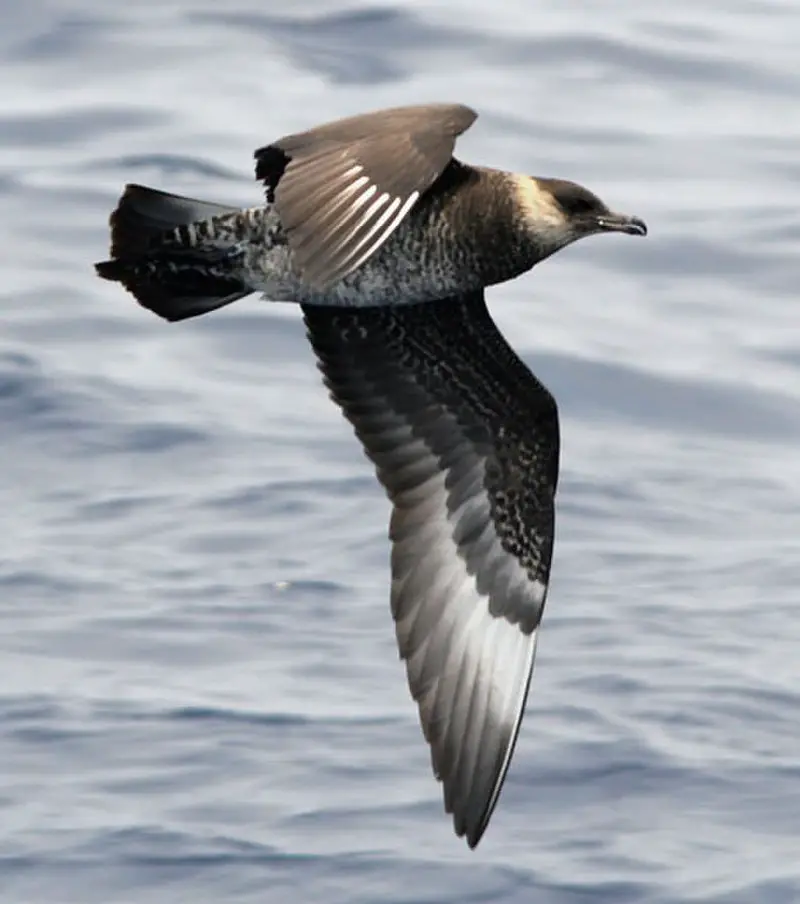
Skuas are a group of predatory seabirds with seven species, all belonging to the genus Stercorarius.
They are also known as “Jaegers” in North America and their name originates from the Faroese word for Great Skua – skúgvur.
These birds typically inhabit coastal areas or open oceans where they feed on fish, krill and other marine creatures.
Skuas can be distinguished by their pointed wings which help them fly long distances while hunting food.
Their distinctive colouration varies depending on age and habitat but generally includes greyish brown upperparts and white underparts with black streaks along its belly area.
The overall size ranges from 24-40 cm making these one of the larger sea bird species.Scientific classification:
| Kingdom | Animalia |
| Phylum | Chordata |
| Class | Aves |
| Order | Charadriiformes |
| Suborder | Lari |
| Family | Stercorariidae Gray, 1871 |
| Genus | Stercorarius Brisson, 1760 |
Also Featured In: Birds of Morocco, Syrian Birds You Need to Know
15. Black Skimmer
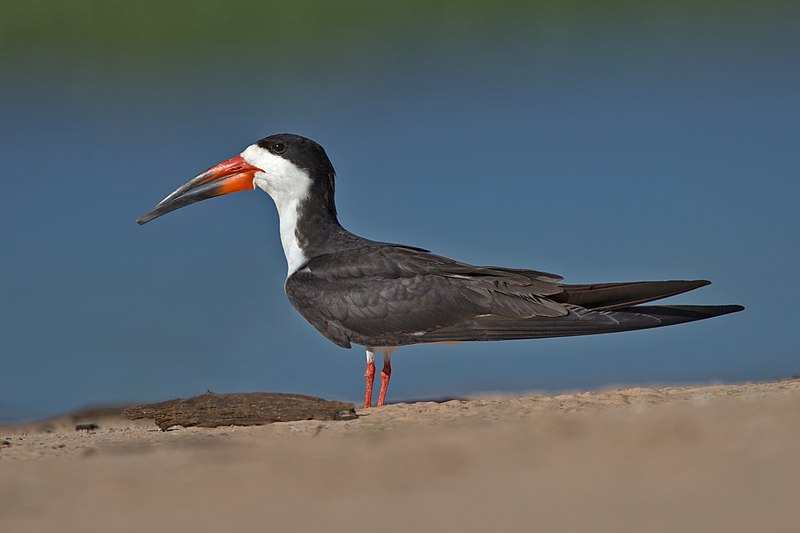
The Black Skimmer is a seabird which belongs to the skimmer genus Rynchops and Laridae family.
It breeds in North and South America, while Northern populations migrate south for winter towards warmer climates such as the Caribbean or Pacific coasts.
The Southern American races have adapted to annual floods by making shorter migrations during this time.
These birds are easily identified with their unique long red bill that has an upper mandible longer than its lower mandible.
They feed mainly on small fish caught at night when they skim across shallow water using their beak like a knife cutting through waves of water.
Their dark grey back contrasts against white belly feathers creating beautiful patterns in flight, aiding them in catching prey easier due to its camoflauge effect above and below waters surface.Scientific classification:
| Kingdom | Animalia |
| Phylum | Chordata |
| Class | Aves |
| Order | Charadriiformes |
| Family | Laridae |
| Genus | Rynchops |
| Species | R. niger |
Also Featured In: Most Unique Birds in Peru, Birds Live Near San Diego
16. Pelican
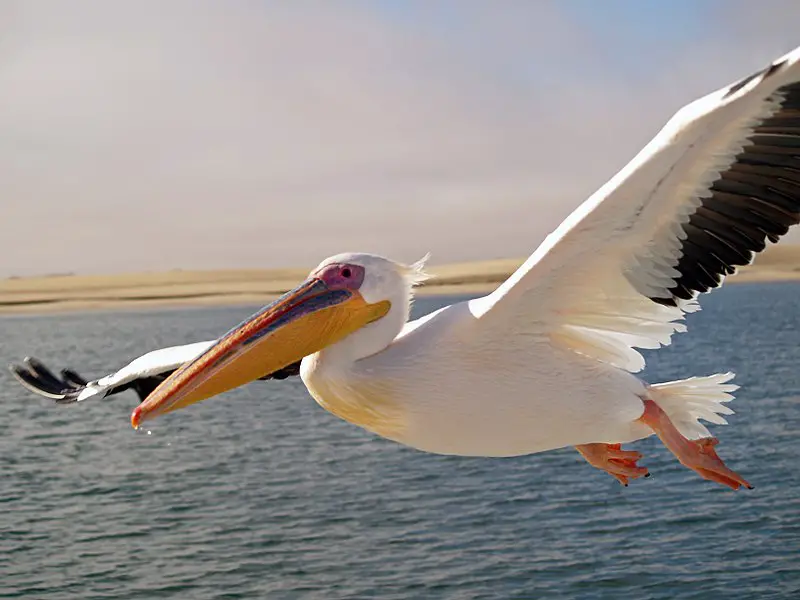
Pelicans are a large water bird and form part of the family Pelecanidae. They have long beaks, allowing them to scoop up prey from both land and sea with ease.
Their most distinctive feature is their huge throat pouch which they use to drain water before swallowing their food.
Most pelican species have predominantly pale plumage however exceptions such as the brown and Peruvian pelicans exhibit darker colouring.
The bill, face skin and pouch of all Pelican species become brightly coloured during breeding season in order to attract mates.
Pelicans can often live up to 25 years due to the fact that they eat mostly fish which provides them with enough nutrients for longevity.Scientific classification:
| Kingdom | Animalia |
| Phylum | Chordata |
| Class | Aves |
| Order | Pelecaniformes |
| Family | Pelecanidae |
| Genus | Pelecanus Linnaeus, 1758 |
Also Featured In: Most common birds in Australia, Sydney Birds You Need to See
17. Blue-Footed Booby
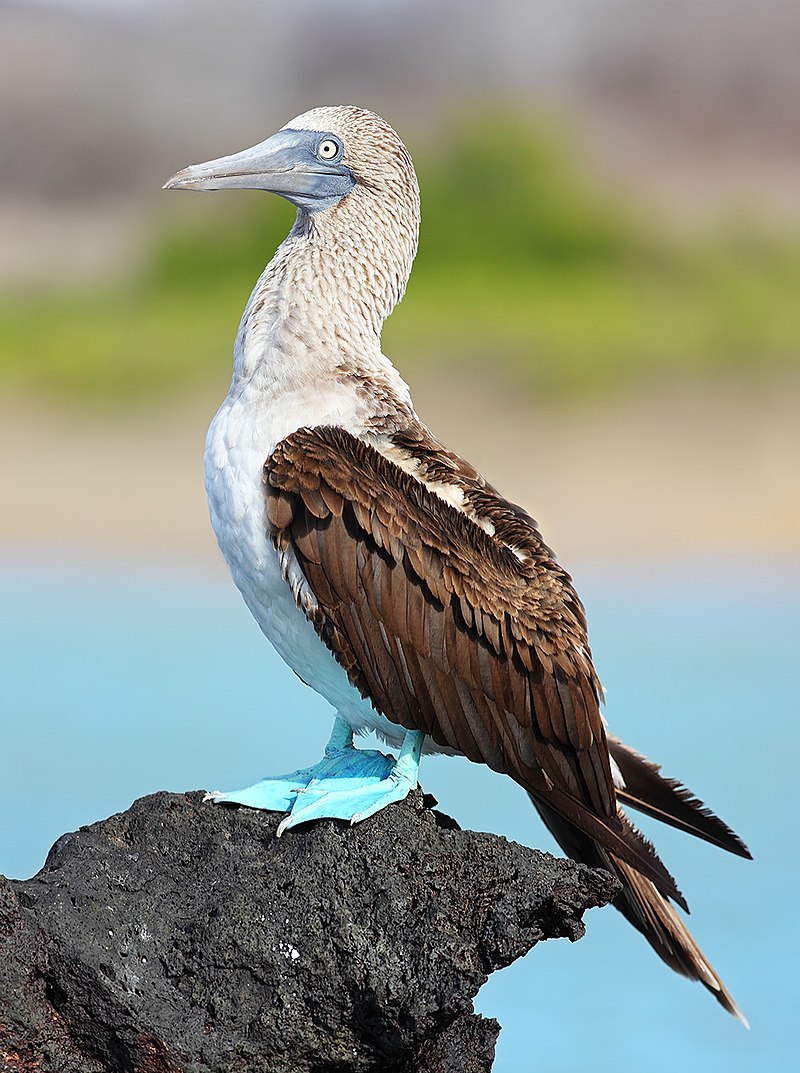
The blue-footed booby is a marine bird that can be found in subtropical and tropical parts of the eastern Pacific Ocean.
It’s one of six species from the same genus, with its unique bright blue feet being a product of their diet as well as an attractive mating ritual for males.
During this ritual, they lift up their feet to show off their brilliant colouring to potential mates.
Boobies are excellent divers, using these skills primarily to hunt fish and squid close by reefs or open ocean waters – plunging into the sea from heights between 10–30 metres.
They also feed on smaller prey such as crustaceans which float near the surface.
Their wingspan averages 1 metre across, making them graceful flyers over large distances both on land and above water surfaces alike.Scientific classification:
| Kingdom | Animalia |
| Phylum | Chordata |
| Class | Aves |
| Order | Suliformes |
| Family | Sulidae |
| Genus | Sula |
| Species | S. nebouxii |
Also Featured In: Birds of Ecuador, Common Latin America Birds
18. Frigatebird
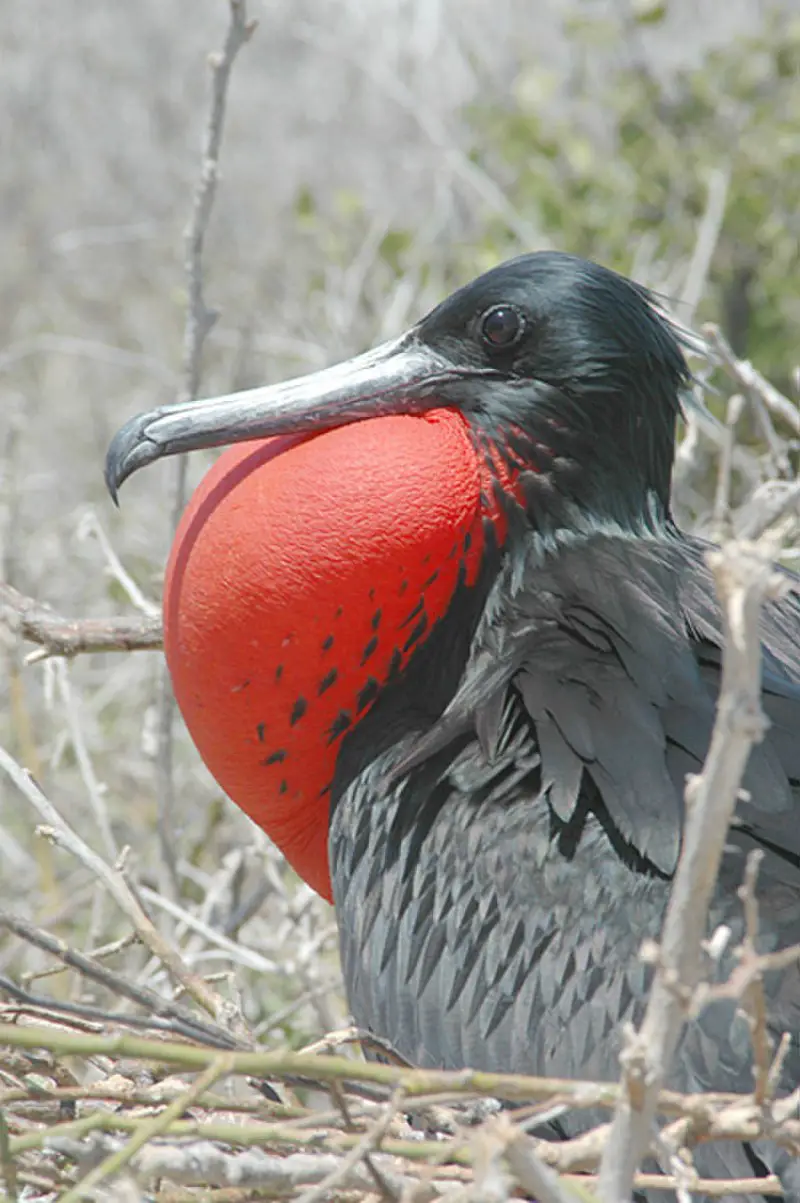
Frigatebirds are a beautiful and mysterious family of seabirds, found in all tropical and subtropical oceans. The five extant species have glossy black plumage, long forked tails, and lengthy hooked bills.
During the breeding season males display a bright red gular pouch which they inflate to attract mates. Females have white underbellies year-round giving them an elegant contrast against their darker feathers.
They spend most of their lives soaring with minimal effort over warm ocean waters seeking food such as fish or squid taken from the surface or plucked out of midair by other birds.
Frigatebirds often nest on isolated islands due to lack of predators yet still manage to travel incredibly large distances between feeding grounds every day making them truly remarkable creatures.Scientific classification:
| Kingdom | Animalia |
| Phylum | Chordata |
| Class | Aves |
| Order | Suliformes |
| Family | Fregatidae Degland & Gerbe, 1867 |
| Genus | Fregata Lacépède, 1799 |
Also Featured In: Birds You’ll Find in the Marshall Islands, Birds of Goa
19. Boobies
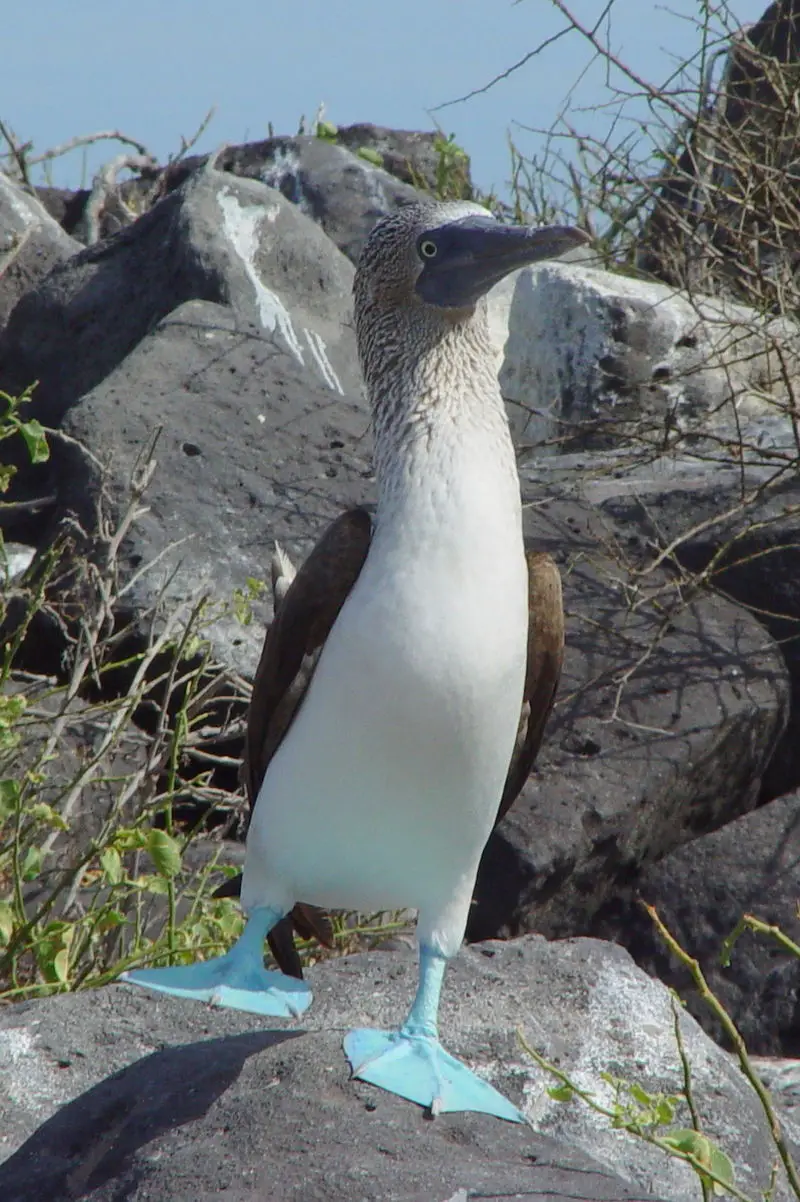
Boobies are seabirds from the family Sulidae. They were originally classified in the genus Sula, and are closely related to gannets (Morus).
Boobies get their name from the Old Norse term “súla,” which was used for another member of their family—the gannet.
These birds can be identified by their brown feathers, long wingspan, webbed feet and sharp bills that they use to catch fish.
Despite being clumsy on land due to their large size and small legs, boobies excel at flying over oceans where they hunt for food with great agility and grace.
Their powerful flaps help them dive quickly underwater as well.Scientific classification:
| Kingdom | Animalia |
| Phylum | Chordata |
| Class | Aves |
| Order | Suliformes |
| Family | Sulidae |
| Genus | Sula Brisson, 1760 |
Also Featured In: Birds of Galápagos Islands You Need to Know,
20. Black-Legged Kittiwake
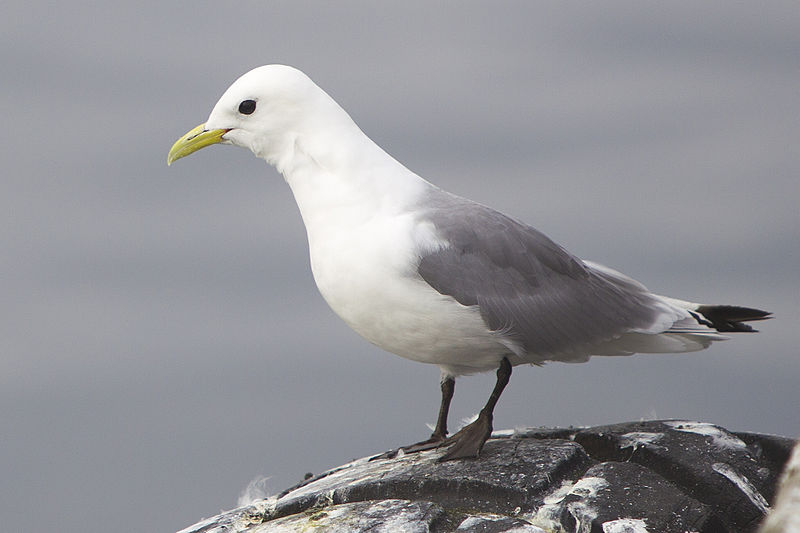
The Black-legged Kittiwake is a seabird of the gull family Laridae. It was first described by Carl Linnaeus in 1758 and its name derives from its distinctive call which sounds like ‘kittee-wa-aaake, kitte-wa-aaake’.
These birds are mainly found along coastal regions with plenty of food sources such as plankton and fish. They have white bodies with slate grey wings and black legs.
The bill is yellowish orange to red depending on age or season.
In winter they migrate southwards away from their northern habitats into warmer waters for breeding purposes before returning again once spring arrives.Scientific classification:
| Kingdom | Animalia |
| Phylum | Chordata |
| Class | Aves |
| Order | Charadriiformes |
| Family | Laridae |
| Genus | Rissa |
| Species | R. tridactyla |
Also Featured In: Birds of Netherlands, Birds that Live in Svalbard
21. Wilson’s Storm Petrel
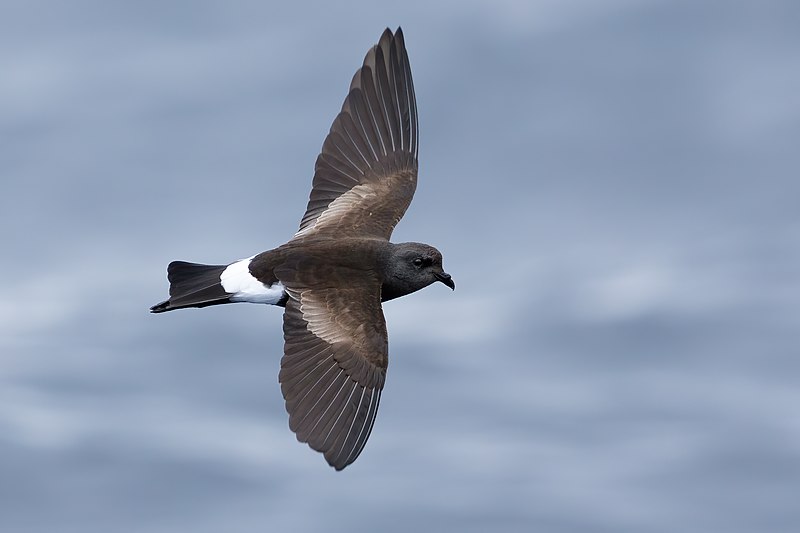
Wilson’s storm petrel is a small seabird of the Oceanitidae family. A circumpolar species, it can be found in both northern and southern hemispheres during summertime.
It has an abundance population estimated to be around 20 million birds as of 2022 making it one of the most populous bird species on Earth.
This nocturnal creature loves to feed on crustaceans, fish eggs and larval fishes that they catch while flying at night over open waters near coasts or islands.
During daylight hours Wilson’s Storm Petrel will rest in large groups and form colonies with fellow members for protection against predators like gulls and skuas which steal their food supplies if given opportunity.Scientific classification:
| Kingdom | Animalia |
| Phylum | Chordata |
| Class | Aves |
| Order | Procellariiformes |
| Family | Oceanitidae |
| Genus | Oceanites |
| Species | O. oceanicus |
Also Featured In: Dominican Republic birds, Birds Live in Tunisia
22. Northern Gannet
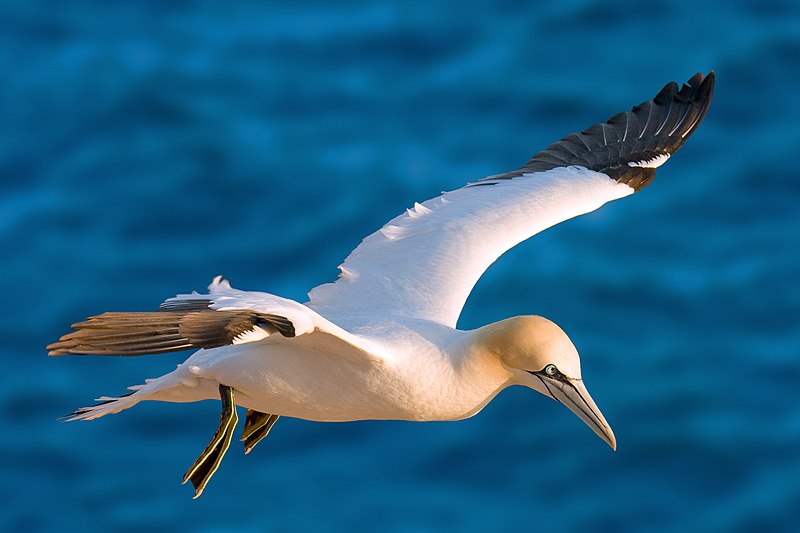
The Northern Gannet is the largest species of seabird in the northern Atlantic, with a white body and long neck.
It has yellowish head feathers and black tipped wings that can reach up to 6 feet across when fully extended.
The beak is large and orange-yellow in color. This bird breeds along western Europe’s coasts as well as northeastern North America.
They forage for fish by plunging into the sea from high above, making them an impressive sight to behold on any given day.
Their diet consists mainly of herring, mackerels or sand eels which they catch midair after diving at speeds reaching over 100 miles per hour.
With their striking features these birds are truly majestic creatures that have been around since prehistoric times – a testament to their hardiness and adaptability.Scientific classification:
| Kingdom | Animalia |
| Phylum | Chordata |
| Class | Aves |
| Order | Suliformes |
| Family | Sulidae |
| Genus | Morus |
| Species | M. bassanus |
Also Featured In: Birds found in portugal, Belarus Birds You Should Know
23. Oystercatchers
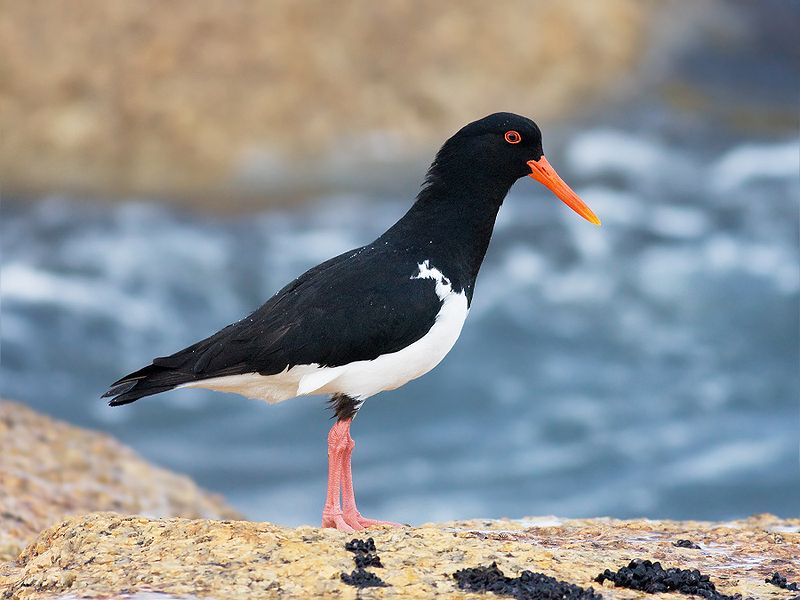
Oystercatchers are a family of waders forming the Haematopodidae, with one genus; Haematopus.
They live in coastal regions around the world excluding both polar and some tropical areas of Africa & South East Asia.
Eurasian, South Island & Magellanic oystercatcher species also breed far inland – breeding grounds being found much deeper than other members of the family.
They have long beaks used to feed on molluscs such as mussels, clams and oysters which they crack open using their strong bills.
Oystercatchers are usually quite vocal birds making various loud calls when disturbed or alarmed.
The males tend to display more brightly coloured plumage compared to females who share similar brown/black hues for camouflage purposes during nesting season.Scientific classification:
| Kingdom | Animalia |
| Phylum | Chordata |
| Class | Aves |
| Order | Charadriiformes |
| Suborder | Charadrii |
| Family | Haematopodidae Bonaparte, 1838 |
| Genus | Haematopus Linnaeus, 1758 |
Also Featured In: Best Birds Watching in Austria, Native Birds of Kazakhstan
24. Common Murre
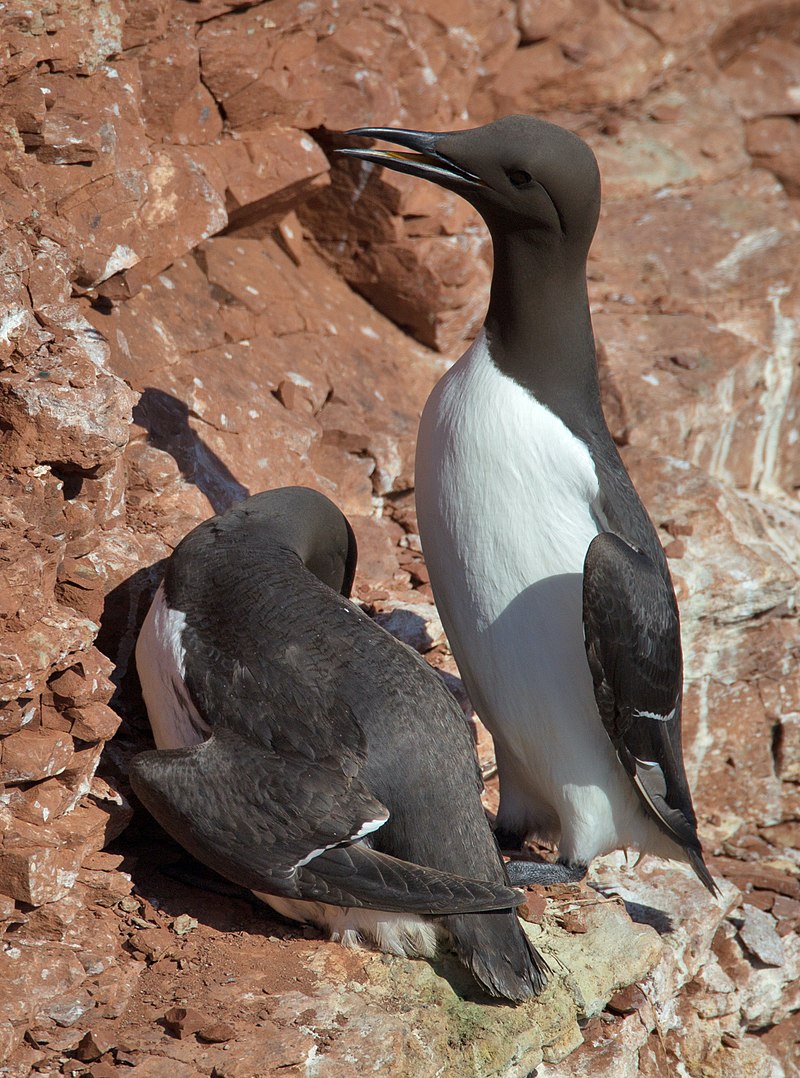
The Common Murre, also known as a Common Guillemot is an Arctic and Boreal seabird that can be seen in North Atlantic and North Pacific oceans.
It has a stocky body with white underparts, black upper parts and striking yellow legs.
They are relatively large birds compared to their relatives but have weak flying abilities – they fly fast but not very agilely.
Their agility lies underwater instead where they are able to dive deep into the ocean depths for food such as fish, crustaceans or molluscs.
During breeding season these birds come ashore on rocky cliffsides or islands where they create burrows for nesting purposes.
The female lays one egg each year which both parents share incubation duties over it until hatching at around 30 days later.Scientific classification:
| Kingdom | Animalia |
| Phylum | Chordata |
| Class | Aves |
| Order | Charadriiformes |
| Family | Alcidae |
| Genus | Uria |
| Species | U. aalge |
Also Featured In: Norway Birds, Birds of Orkney
25. Albatrosses
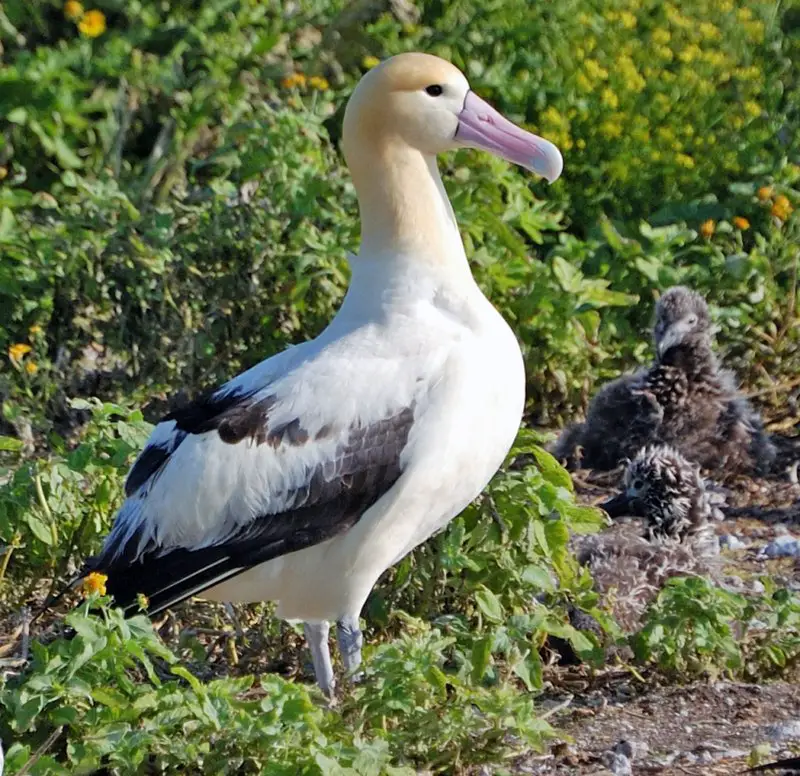
Albatrosses are majestic, large seabirds belonging to the Diomedeidae family in the Procellariiformes order.
These birds have an impressive wingspan and can fly great distances over oceans with minimal effort.
They inhabit all of the world’s southern oceans, ranging from Antarctica up through New Zealand and Australia as well as parts of the northern Pacific Ocean region.
Albatross populations were once abundant throughout much of their range but they now face threats such as longline fishing gear entanglement which has caused a significant decline in numbers in some areas.
Furthermore, occasional vagrants have been found outside their native ranges including fossil remains suggesting that albatrosses previously existed on other regions too.Scientific classification:
| Kingdom | Animalia |
| Phylum | Chordata |
| Class | Aves |
| Order | Procellariiformes |
| Family | Diomedeidae G.R. Gray 1840[1] |
Also Featured In: New Zealand Birds, Birds of Symbolism
26. White-Tailed Tropicbird
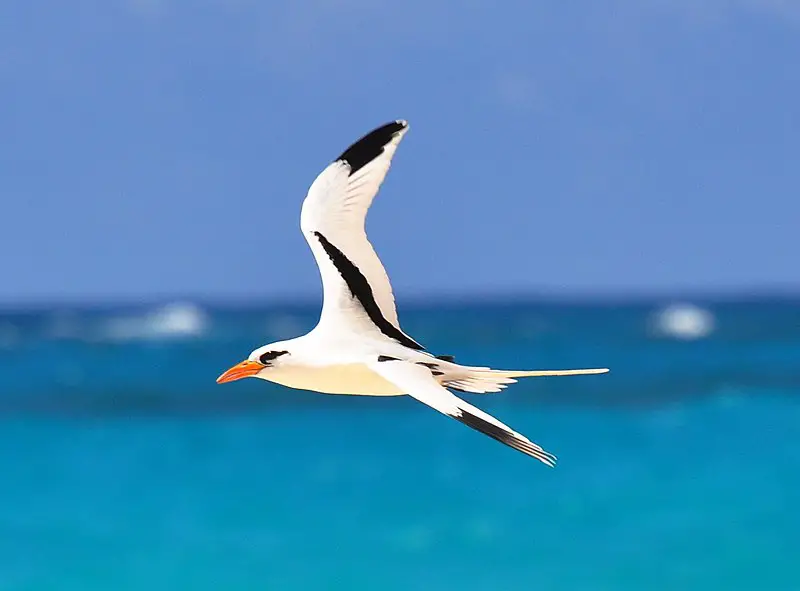
The White-tailed Tropicbird is a beautiful seabird that lives in the tropical waters of the Atlantic, Pacific, and Indian Oceans.
It is the smallest member of its order Phaethontiformes, measuring only 28 inches from head to tail.
Its wingspan can reach up to 45 inches wide. The bird has white plumage with black markings on its wings and tail feathers.
It also has an unmistakable long streamer which trails out behind them when they are in flight – a characteristic feature for all tropicbirds.
They nest mainly on remote islands throughout their range but have recently begun nesting on Little Tobago as well.
These birds feed primarily off flying fish or squid near the ocean’s surface during daylight hours before returning back home at nightfall.Scientific classification:
| Kingdom | Animalia |
| Phylum | Chordata |
| Class | Aves |
| Order | Phaethontiformes |
| Family | Phaethontidae |
| Genus | Phaethon |
| Species | P. lepturus |
Also Featured In: Mauritius birds, Birds of Kauai, Hawaii
27. Northern Fulmar
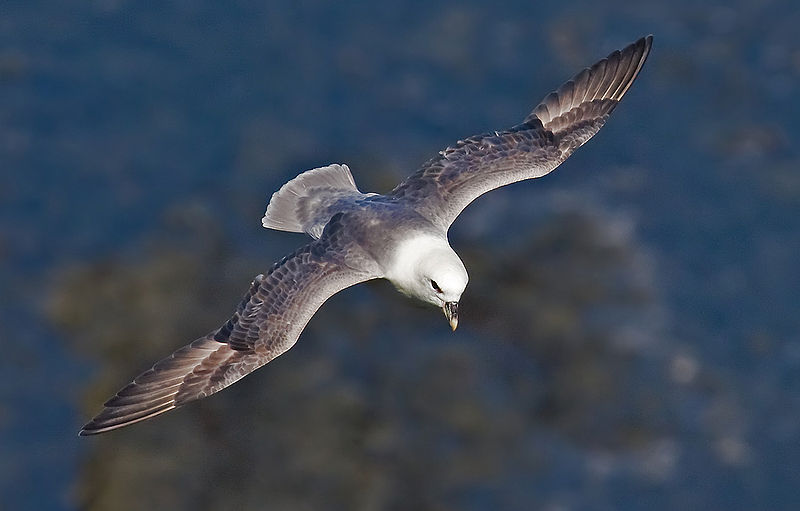
The Northern Fulmar is a seabird that resides in the subarctic regions of the North Atlantic and North Pacific oceans. It has one distinctive color morph: white head and body, along with gray wings.
This bird had been seen only once in Southern Hemisphere south from New Zealand due to its habitat preferences.
Its diet includes fish eggs, crustaceans, small squid and other marine animals which they consume while flying over water surface or when swimming on sea’s top layer looking for food.
The Fulmar also scavenges carrion, especially during breeding season as their chicks need more nutrition than adult birds do.
They are highly abundant species so no conservation measures have been taken yet but monitoring them helps us understand population dynamics better.Scientific classification:
| Kingdom | Animalia |
| Phylum | Chordata |
| Class | Aves |
| Order | Procellariiformes |
| Family | Procellariidae |
| Genus | Fulmarus |
| Species | F. glacialis |
Also Featured In: Iceland birds,
28. Razorbill
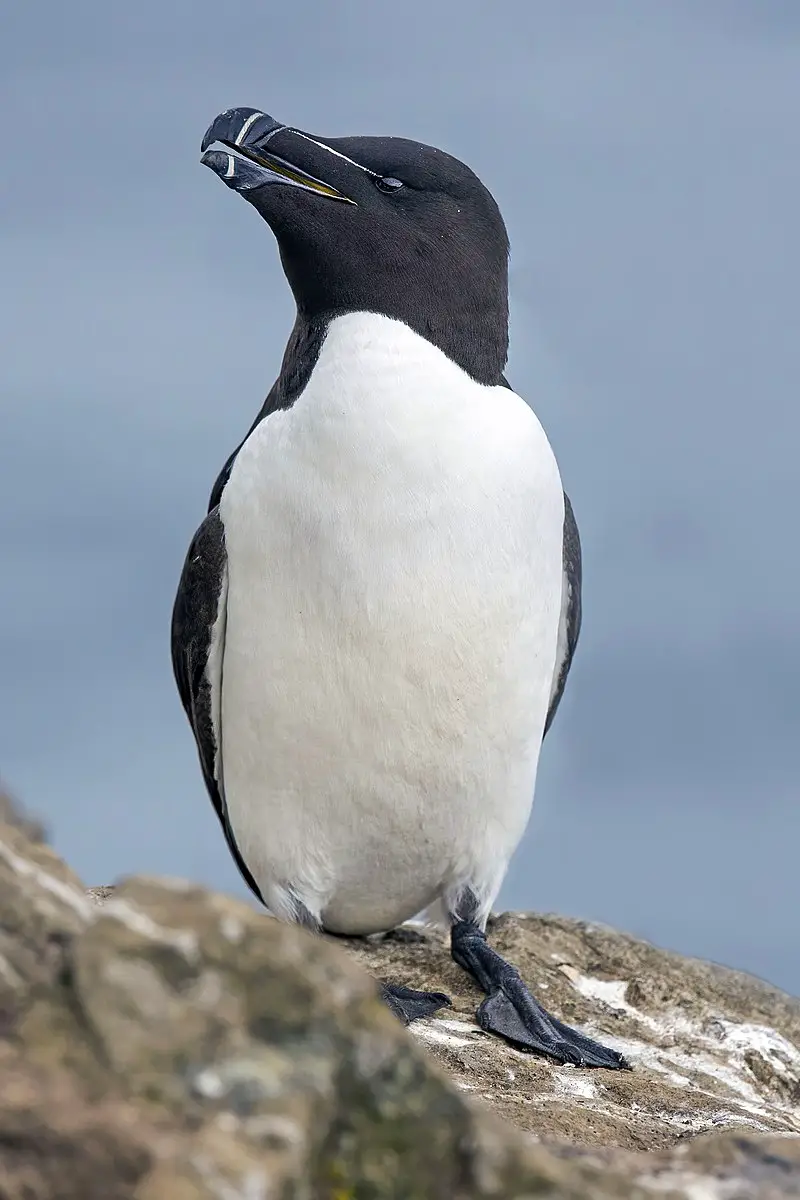
The Razorbill is a seabird of the family Alcidae and is closely related to the extinct great auk. It lives in subarctic waters of the Atlantic Ocean, primarily black with white underside and both male and female look identical.
They have long pointed wings which help them dive underwater for their food that consists mainly of fish and crustaceans.
Usually they form large colonies on cliffs or rocky islands but can also be found solitary during breeding season when pairs nest together in crevices or rock ledges near sea level.
During winter they migrate southwards into open water areas where they stay until spring arrives again before returning back to breed once more.
The razorbill’s population has been declining due to human activity such as overfishing so conservation efforts are being made by governments across Europe in order to protect this species from extinction.Scientific classification:
| Kingdom | Animalia |
| Phylum | Chordata |
| Class | Aves |
| Order | Charadriiformes |
| Family | Alcidae |
| Genus | Alca |
| Species | A. torda |
Also Featured In: Black And White Birds You Don’t Know About, Birds That Live in Benbecula You Should Know
29. Great Black-Backed Gull
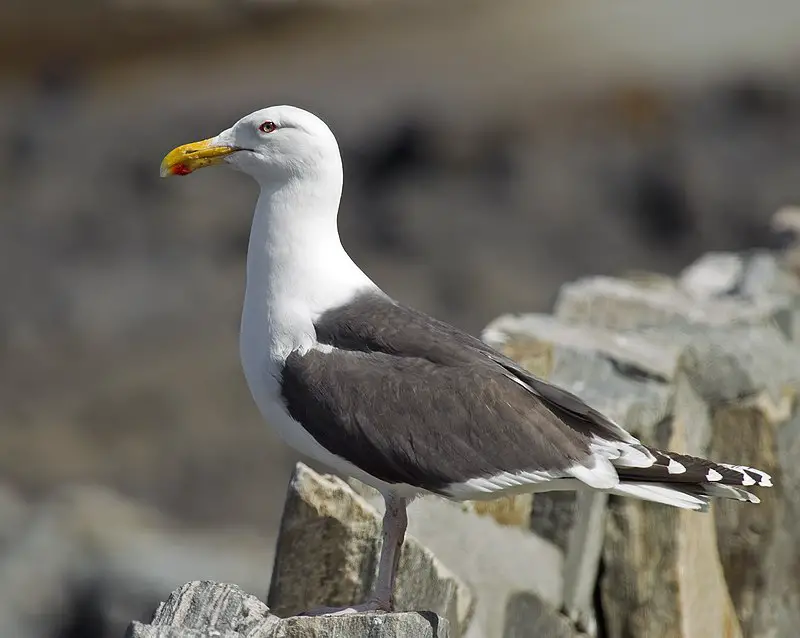
The Great Black-Backed Gull is the largest member of its family and aptly named as “king of the Atlantic waterfront”.
It can be found on both European and North American coasts, islands in the North Atlantic, or farther inland near large lakes.
This seabird is an aggressive hunter with a tendency to scavenge for food that it may not have caught itself.
In addition to their formidable hunting skills they are also adept at stealing from other birds who have successfully managed to catch something themselves.
As such they are known for being very territorial when defending their nests during mating season.
The powerful wingspan of this majestic species make them able to soar through even strong winds but still remain graceful while doing so.
All these characteristics combined show why great black-backed gulls truly live up to their name as kings among seafaring birds.Scientific classification:
| Kingdom | Animalia |
| Phylum | Chordata |
| Class | Aves |
| Order | Charadriiformes |
| Family | Laridae |
| Genus | Larus |
| Species | L. marinus |
Also Featured In: Birds of Nova Scotia, Acadia National Park Birds
30. Penguins
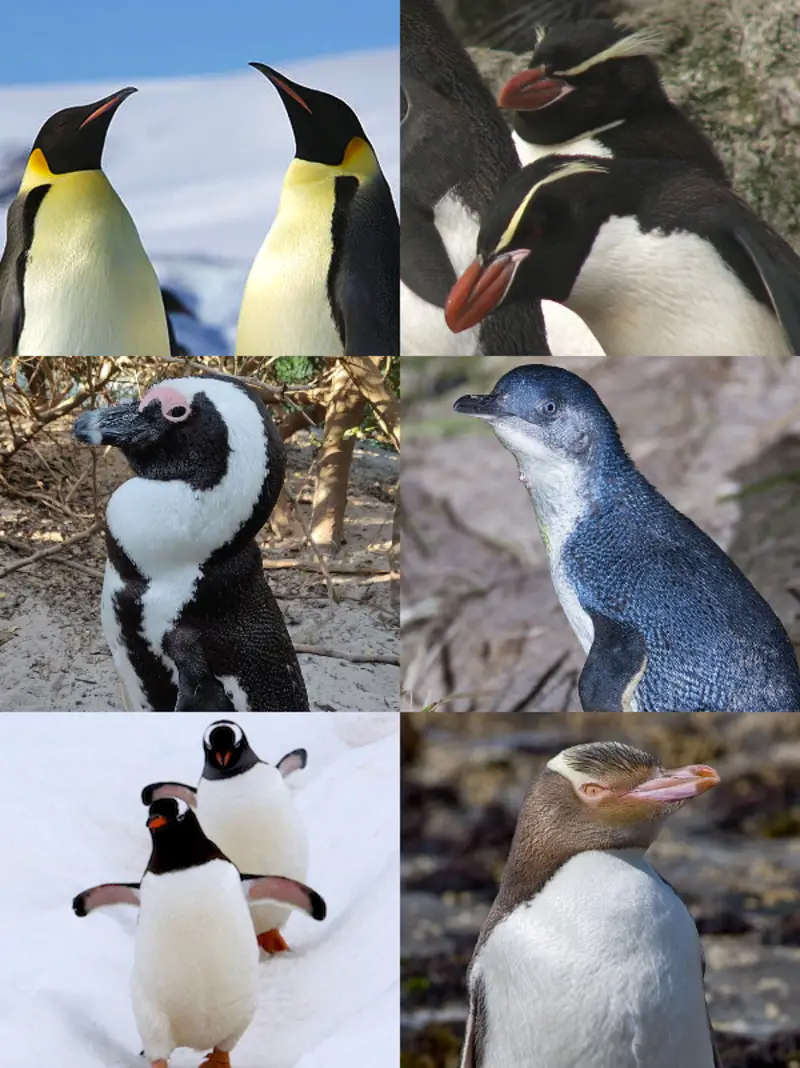
Penguins are an amazing species of aquatic birds that live mainly in the Southern Hemisphere. They have a unique plumage, which is black and white countershaded to aid them while swimming in the water.
Penguins feed mostly on krill, small crustaceans found near Antarctica. These remarkable creatures can’t fly but they compensate by being excellent swimmers due to their flippers-like wings which help them move faster underwater.
All this makes penguins one of nature’s most fascinating animals – not just for kids.Scientific classification:
| Kingdom | Animalia |
| Phylum | Chordata |
| Class | Aves |
| Clade | Austrodyptornithes |
| Order | Sphenisciformes Sharpe, 1891 |
| Family | Spheniscidae Bonaparte, 1831 |
Also Featured In: Antarctica Birds, Birds You’ll Find in Zoo
31. Wandering Albatross
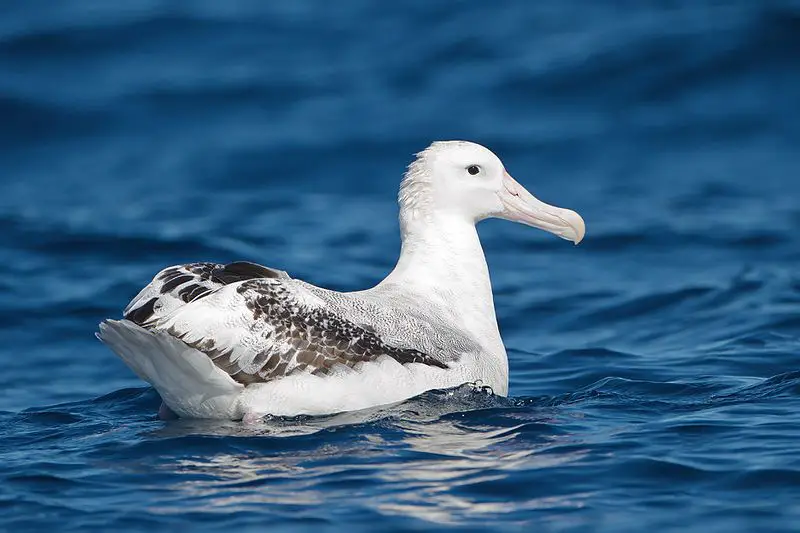
The Wandering Albatross is a large seabird from the family Diomedeidae found in the Southern Ocean. It has white wings, black tips and a long hooked bill.
With its impressive wingspan of up to 3m they are one of largest birds that can fly.
They spend most their lives far out at sea only coming to land for breeding season on remote islands where they nest on cliffs or rocky areas close by the ocean.
The species was first described in 1783 but had been considered similar to other albatrosses such as Tristan Albatross and Antipodean Albatross until recently when it was recognized as an individual species due to genetic studies showing differences between them.Scientific classification:
| Kingdom | Animalia |
| Phylum | Chordata |
| Class | Aves |
| Order | Procellariiformes |
| Family | Diomedeidae |
| Genus | Diomedea |
| Species | D. exulans |
Also Featured In: Patagonia Birds You Should Know, Common Birds Found near Saint Helena
32. Emperor Penguin
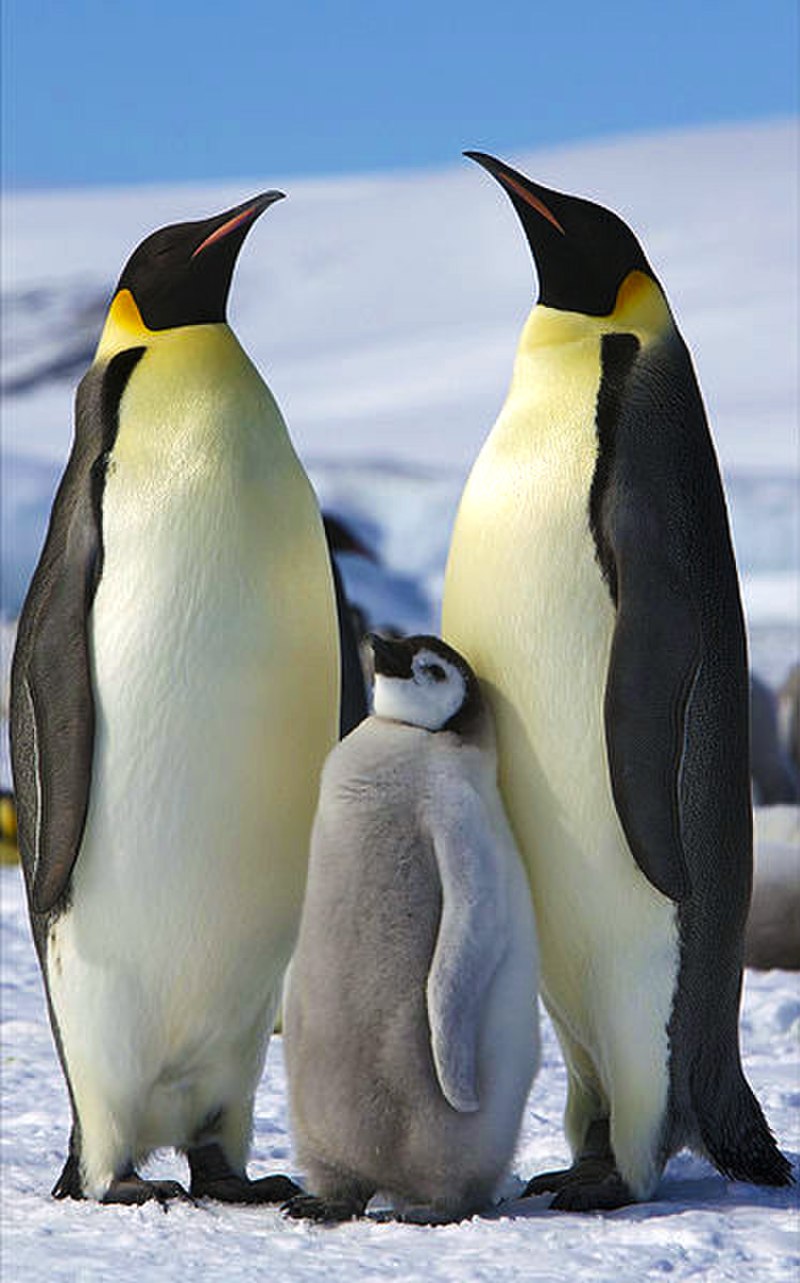
The Emperor penguin is an amazing bird – the tallest and heaviest of all living penguins. It has a unique plumage with black head and back feathers sharply contrasted against its white belly, pale-yellow breast, and bright-yellow ear patches.
Reaching up to 100 cm in length and weighing between 22–45 kg, it’s truly a sight to behold.
The Emperor Penguin is endemic to Antarctica where they feed on krill fish or squid depending on the season. Breeding occurs during the harsh winter months when temperatures can drop as low as −40 °C (−40 °F).
Despite this extreme climate their remarkable adaptations allow them to survive in these unforgiving conditions – making them one of nature’s true marvels.Scientific classification:
| Kingdom | Animalia |
| Phylum | Chordata |
| Class | Aves |
| Order | Sphenisciformes |
| Family | Spheniscidae |
| Genus | Aptenodytes |
| Species | A. forsteri |
Also Featured In: Tundra Birds,
33. Little Auk
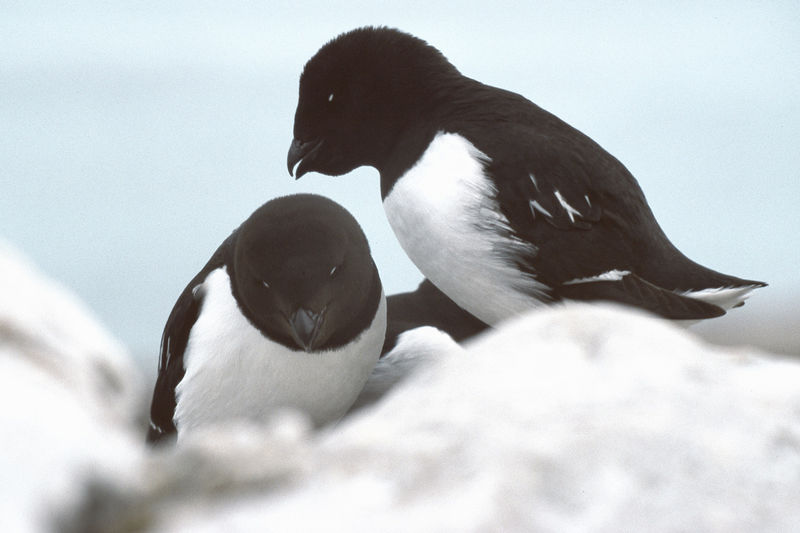
The Little Auk, also known as the Dovekie or Alle alle is a small but mighty bird. It has an unmistakable call that sounds like “alle” and is how it gets its name – taken from the Sami language of northern Scandinavia.
These birds are found in large flocks during winter months where they migrate to far north polar regions for feeding on fish, molluscs and crustaceans.
They nest near coasts in rocky areas with low vegetation cover making them difficult to spot amongst their natural habitat.
With numbers declining due to overfishing it’s important we take steps towards protecting this beautiful species so future generations can enjoy these little creatures too.Scientific classification:
| Kingdom | Animalia |
| Phylum | Chordata |
| Class | Aves |
| Order | Charadriiformes |
| Family | Alcidae |
| Genus | Alle Link, 1806 |
| Species | A. alle |
Also Featured In: Auks Species, Birds that Live in Newfoundland and Labrador
34. Tufted Puffin
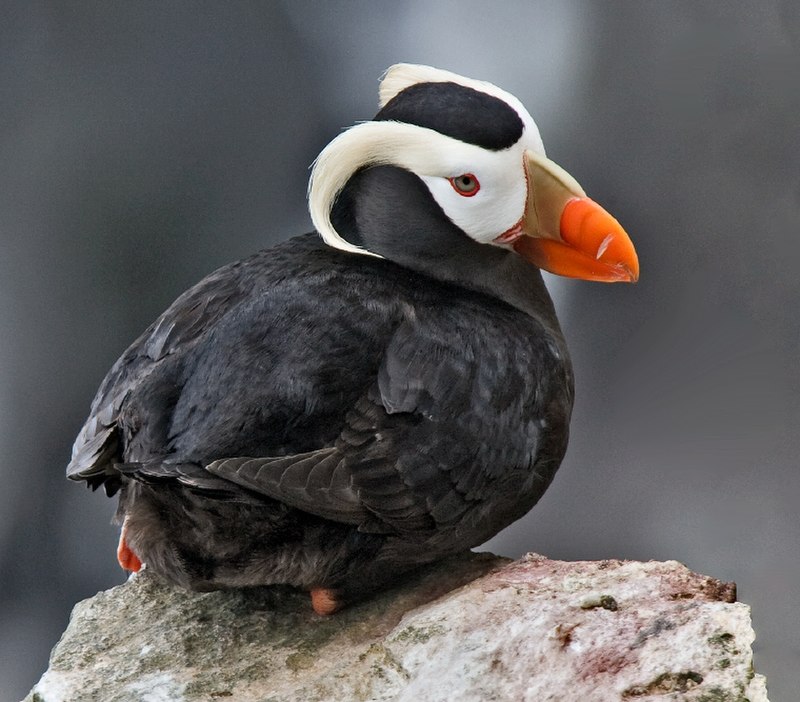
The Tufted Puffin is a medium-sized seabird belonging to the Alcidae family. It can be recognized by its thick red bill and yellow tufts, which give it an unmistakable appearance.
These birds inhabit the North Pacific Ocean and are relatively abundant compared to other species of puffin.
They measure around 35 cm in length with a similar wingspan, making them one of the smaller members of their genus Fratercula.
In terms of feeding habits they mainly eat small fish like herring or anchovies while at sea but also take advantage of food sources near shore when breeding season arrives.
Their eggs are laid in burrows that these feathered creatures dig into cliff faces for protection from predators; once hatched both parents help raise their young until they fledge later on in life.Scientific classification:
| Kingdom | Animalia |
| Phylum | Chordata |
| Class | Aves |
| Order | Charadriiformes |
| Family | Alcidae |
| Genus | Fratercula |
| Species | F. cirrhata |
Also Featured In: Birds that Live in the Ocean , Birds in Pacific Northwest
35. Pigeon Guillemot
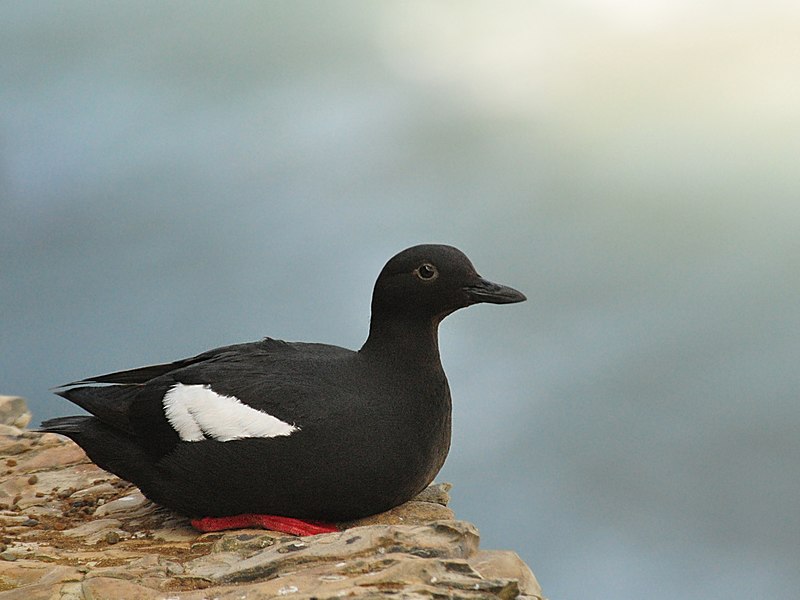
The pigeon guillemot is an interesting species of bird, belonging to the auk family. It has five subspecies, all with striking black and brown plumage that shimmers in sunlight.
When breeding, they have a distinctive wing patch broken up by a brown-black wedge for easy identification.
They are closely related to spectacled guillemots and share many features such as their razor sharp beaks which help them catch fish from the sea depths below.
These birds can often be spotted on rocky shores or offshore islands where there is plenty of food available for them to feed upon.
Their unique appearance makes them stand out amongst other types of seabirds making it easier for us humans to observe these wonderful creatures.Scientific classification:
| Kingdom | Animalia |
| Phylum | Chordata |
| Class | Aves |
| Order | Charadriiformes |
| Family | Alcidae |
| Genus | Cepphus |
| Species | C. columba |
Also Featured In: Birds of Oregon Coast, Birds that Live near Bering Island
36. Laysan Albatross
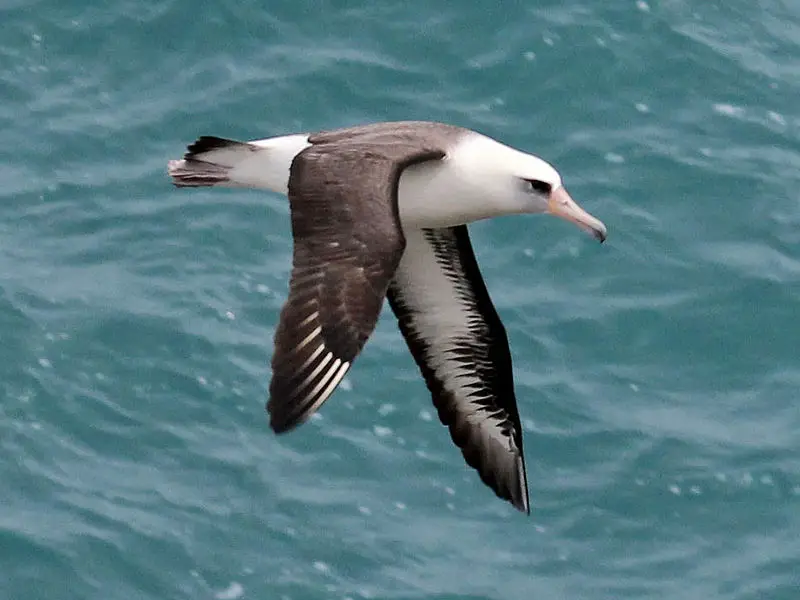
The Laysan albatross is a large seabird found in the North Pacific Ocean. Most of its population (99.7%) can be seen residing in the Northwestern Hawaiian Islands, where they form strong colonies and thrive among their natural habitat there.
They are small for an albatross but still have distinguishable features such as long wingspans that help them soar gracefully above oceans while searching for food over great distances with ease.
It’s estimated to have 1.18 million birds worldwide and continues to expand or re-expand its range throughout other areas of the oceanic region too.Scientific classification:
| Kingdom | Animalia |
| Phylum | Chordata |
| Class | Aves |
| Order | Procellariiformes |
| Family | Diomedeidae |
| Genus | Phoebastria |
| Species | P. immutabilis |
Also Featured In: Albatross Species, Most Common Oahu Birds
37. Black-Footed Albatross
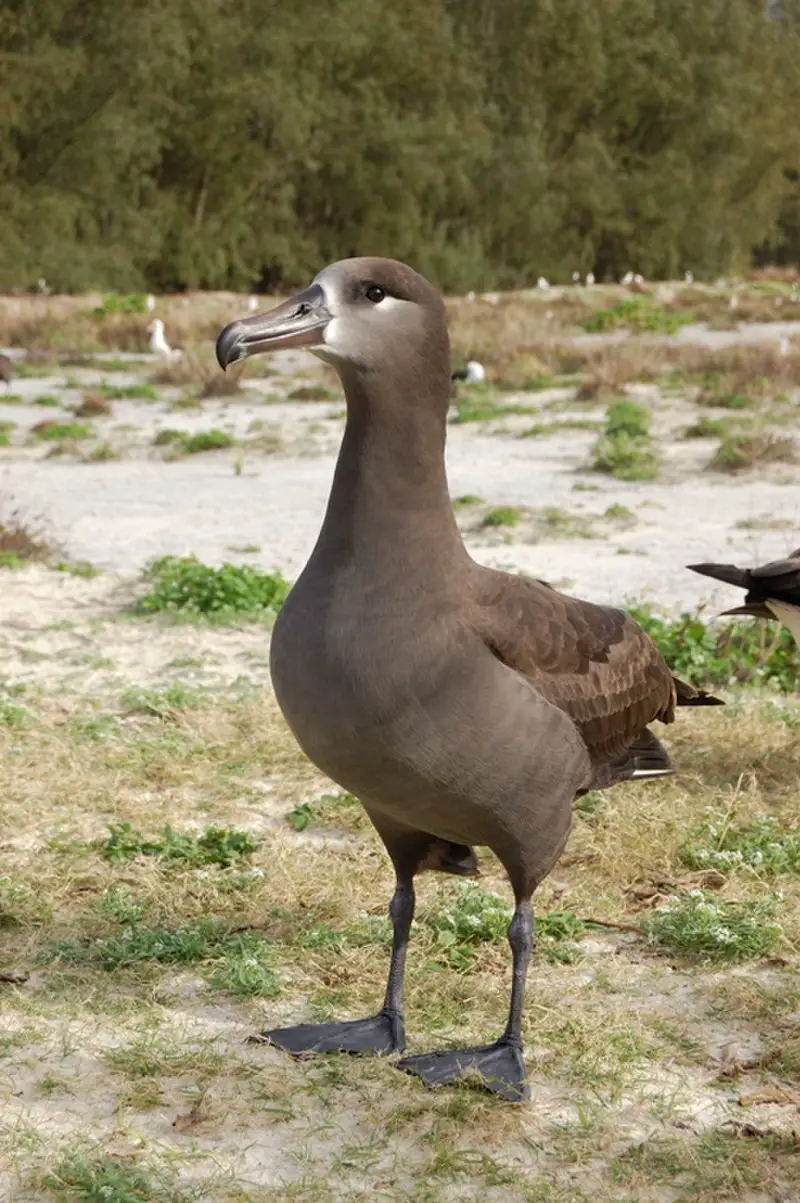
The black-footed albatross is a species of large seabird from the Diomedeidae family, found primarily in North Pacific coastal areas.
It is one of three species of northern hemisphere albatrosses and has dark plumage unlike many others.
These birds are mostly located around the Northwestern Hawaiian Islands where they nest on isolated tropical islands.
The population numbers have been rapidly declining due to human activities such as fishing nets and plastic waste consumption which affects their food sources.
Conservation efforts must be made to protect these majestic creatures before it’s too late.Scientific classification:
| Kingdom | Animalia |
| Phylum | Chordata |
| Class | Aves |
| Order | Procellariiformes |
| Family | Diomedeidae |
| Genus | Phoebastria |
| Species | P. nigripes |
Also Featured In: Most Common Birds of Farallon Islands, Native Birds Of Kure Atoll
38. Nazca Booby
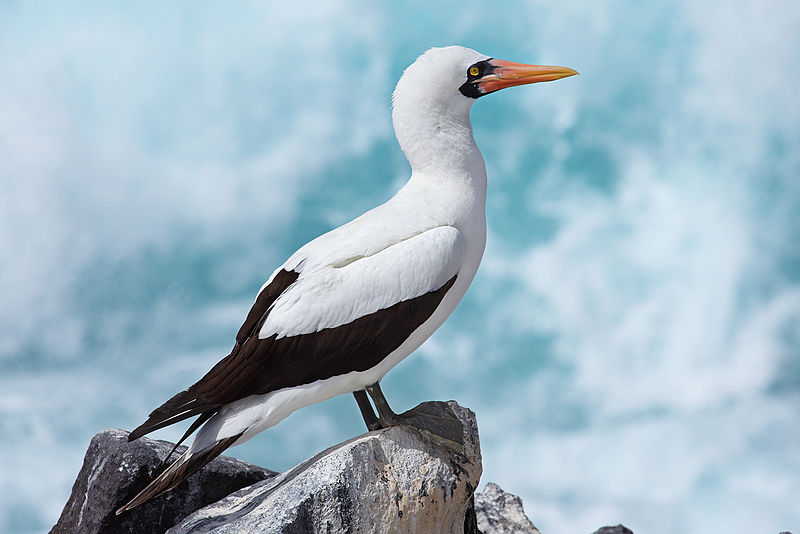
The Nazca booby is a large seabird of the Sulidae family native to the eastern Pacific.
With its long orange-yellow bill and aerodynamic body, it was first described by Walter Rothschild in 1902 and was then considered a subspecies of masked booby until 2002 when genetic differences were noticed.
It has a typical sulid shape with an elongated neck, long wings for faster flight and webbed feet for strong swimming ability.
They feed on squid and small fishes which they catch while flying over the ocean surface or diving from heights up to 30m deep into waters.
During breeding season males perform elaborate courtship displays like sky pointing calls, head nodding ritual dance as well as puffed out chest feathers showcasing their bright colors.Scientific classification:
| Kingdom | Animalia |
| Phylum | Chordata |
| Class | Aves |
| Order | Suliformes |
| Family | Sulidae |
| Genus | Sula |
| Species | S. granti |
Also Featured In: Booby Species, Galapagos Birds You Should Know
39. Brandt’s Cormorant
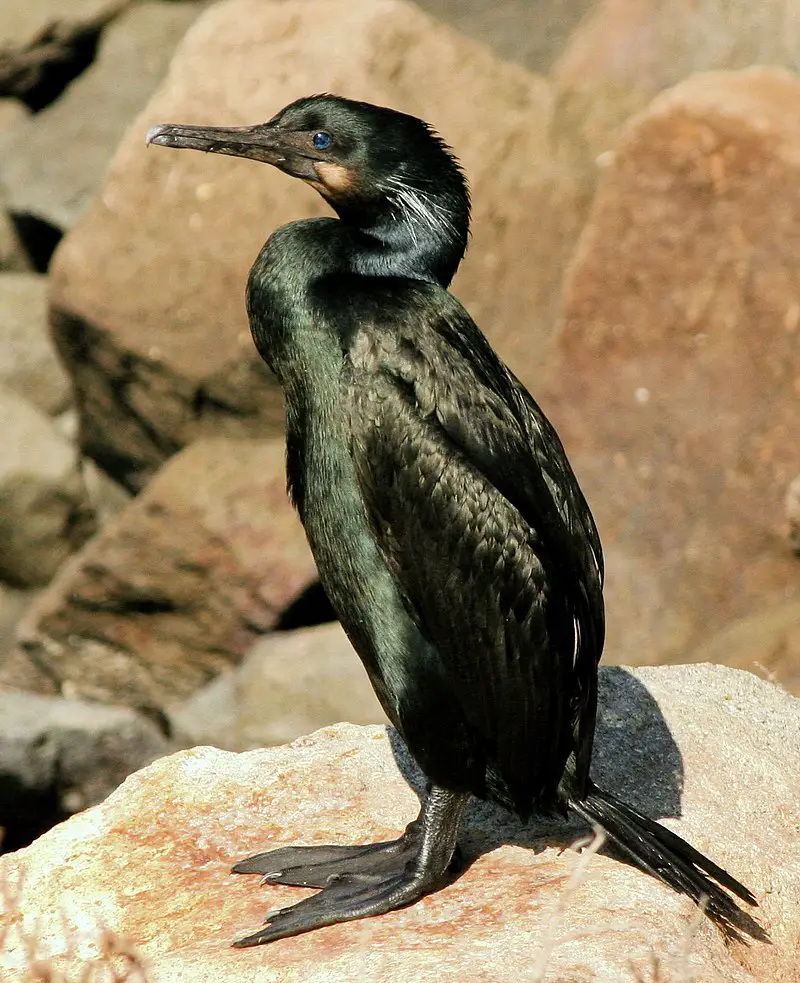
Brandt’s cormorant is a seabird of the Cormorant family that inhabits the Pacific coast of North America.
In summer, it can be found from Alaska to Gulf of California but its population northwards migrate south during winter season.
Its name Penicillatus originates from Latin which means painter’s brush referring to its white plumes on head and neck.
It feeds mainly on small fish like herring, anchovy etc., diving up to 30 m deep for food catch in cold water near shorelines or at sea around offshore islands or continental shelfs.
They breed along rocky shoresline building nests out of seaweed and sticks close together in colonies numbering into hundreds while producing two eggs per year with incubation period lasting 25-35 days before chicks fledge after seven weeks post hatching.
Brandt’s cormorants are considered an important species as they help maintain balance between marine predators and prey by controlling populations through their diet habits .Scientific classification:
| Kingdom | Animalia |
| Phylum | Chordata |
| Class | Aves |
| Order | Suliformes |
| Family | Phalacrocoracidae |
| Genus | Urile |
| Species | U. penicillatus |
Also Featured In: Cormorant Species, Birds that Live in San Francisco Bay Area
40. Sternidae
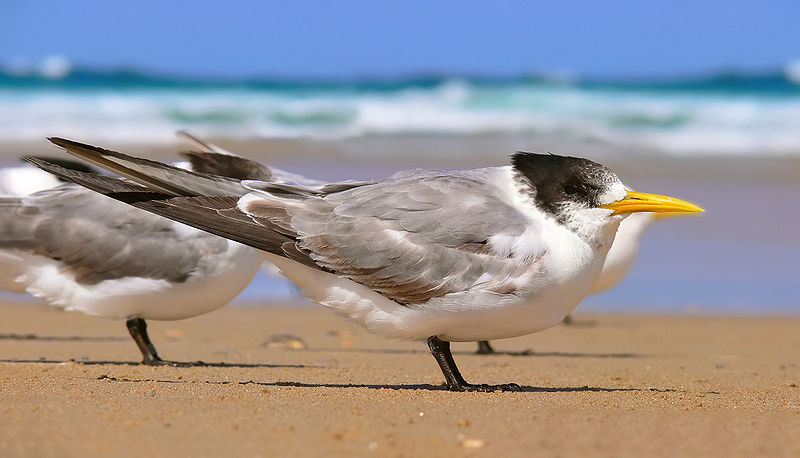
Sternidae are a subgroup of the family Laridae, consisting of eleven genera. They have slender bodies with long forked tails and narrow wings. Their bills are long and their legs relatively short.
Most species display pale grey or white plumage above, while underneath they show black markings on the head along with varying shades of browns elsewhere on their body.
These seabirds can be found in coastal areas near oceans, rivers and wetlands worldwide but especially in North America where they feed primarily on small fish which they capture by swooping down from the air to snatch them up from below the surface.
They also supplement this diet with crustaceans such as crabs when available.Scientific classification:
| Kingdom | Animalia |
| Phylum | Chordata |
| Class | Aves |
| Order | Charadriiformes |
| Family | Laridae |
| Subfamily | Sterninae Bonaparte, 1838 |
Also Featured In: Florida Birds, Water Birds Live around Us
41. Puffins
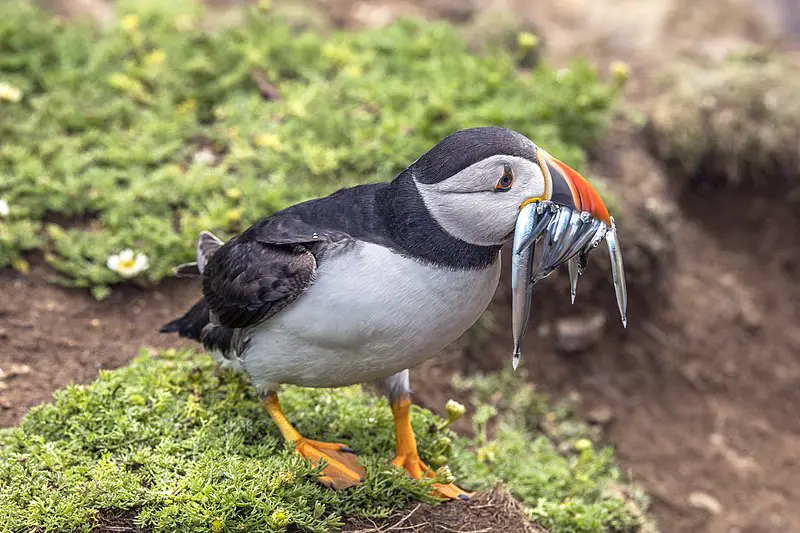
Puffins are small seabirds that belong to the bird genus Fratercula. They primarily feed by diving into the water and breed in colonies on coastal cliffs or offshore islands.
They can nest in crevices among rocks or in burrows in the soil. There are three species of puffins, with two found in the North Pacific Ocean and one in the Atlantic Ocean.
The tufted puffin and horned puffin are North Pacific species, while the Atlantic puffin is the only puffin species found in the Atlantic Ocean.
These birds have colorful beaks that are often compared to clowns’ faces, making them a popular sight among birdwatchers.
Puffins are fascinating creatures that have long been the subject of fascination and study among the scientific community.Scientific classification:
| Kingdom | Animalia |
| Phylum | Chordata |
| Class | Aves |
| Order | Charadriiformes |
| Family | Alcidae |
| Tribe | Fraterculini |
| Genus | Fratercula Brisson, 1760 |
Also Featured In: Famous Paintings Birds, Most Common Nature Birds
42. Fulmars
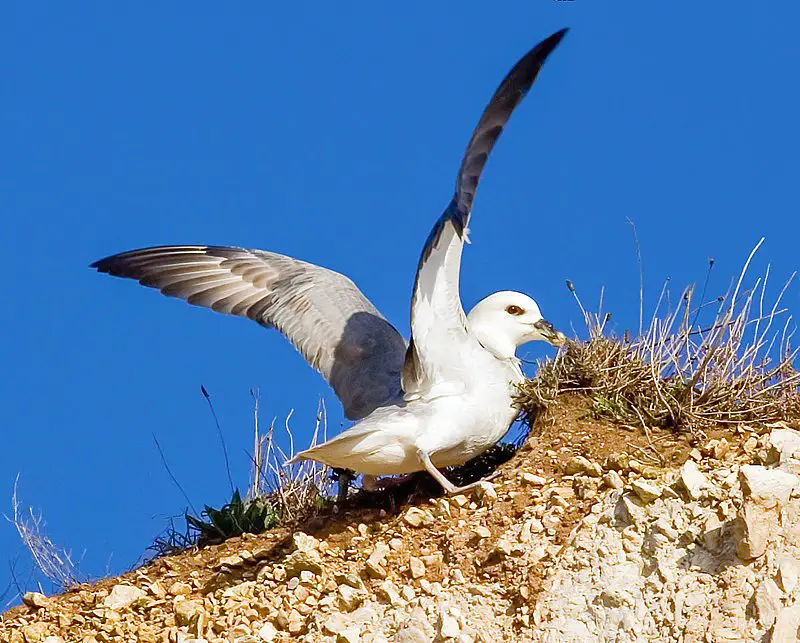
Fulmars are seabirds that belong to the Procellariidae family. They have two current species and two previous fossil species. They look like seagulls, but their flight and tube noses make them distinctive.
Fulmars lay one or two eggs on a ledge of bare rock or on a grassy cliff during breeding season. They nest on cliffs.Scientific classification:
| Kingdom | Animalia |
| Phylum | Chordata |
| Class | Aves |
| Order | Procellariiformes |
| Family | Procellariidae |
| Genus | Fulmarus Stephens, 1826 |
Also Featured In: Most Common Scotland Birds, Shetland Islands Birds You Should Know
43. Sandpiper
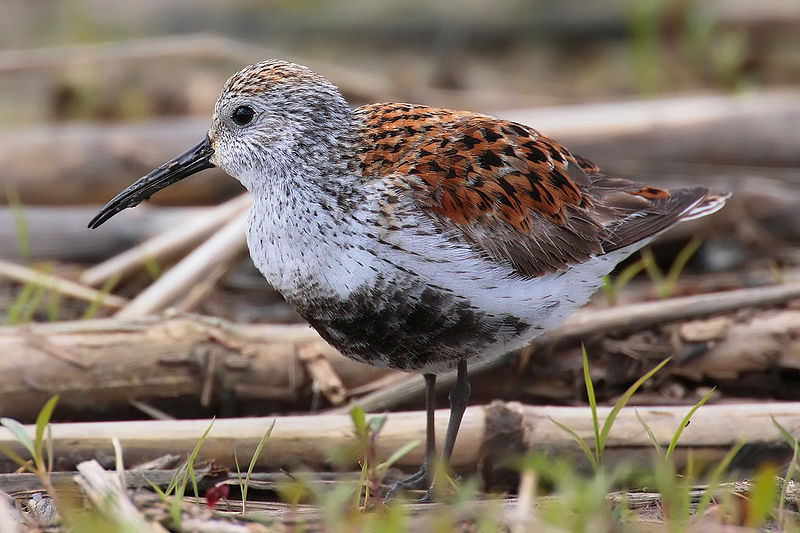
Sandpiper is a type of wading bird that belongs to the family Scolopacidae. It is a diverse family that includes various species such as curlew and snipe.
Sandpipers have different bill lengths that allow them to feed on small invertebrates and creatures found in mud or soil.
Due to this diversity, different species can coexist in the same habitat without competing for food.
Sandpipers are commonly found near the coast but are also found in other wetland environments.
They are known for their slender legs, long beak, and streamlined body that enables them to move easily in and out of water.
Sandpipers are a unique and fascinating bird species that are interesting to observe in their natural habitat.Scientific classification:
| Kingdom | Animalia |
| Phylum | Chordata |
| Class | Aves |
| Order | Charadriiformes |
| Suborder | Scolopaci |
| Family | Scolopacidae Rafinesque, 1815 |
Also Featured In: Turkey Birds You Should Know, Ukrainian Birds You Should Know
44. Guillemot
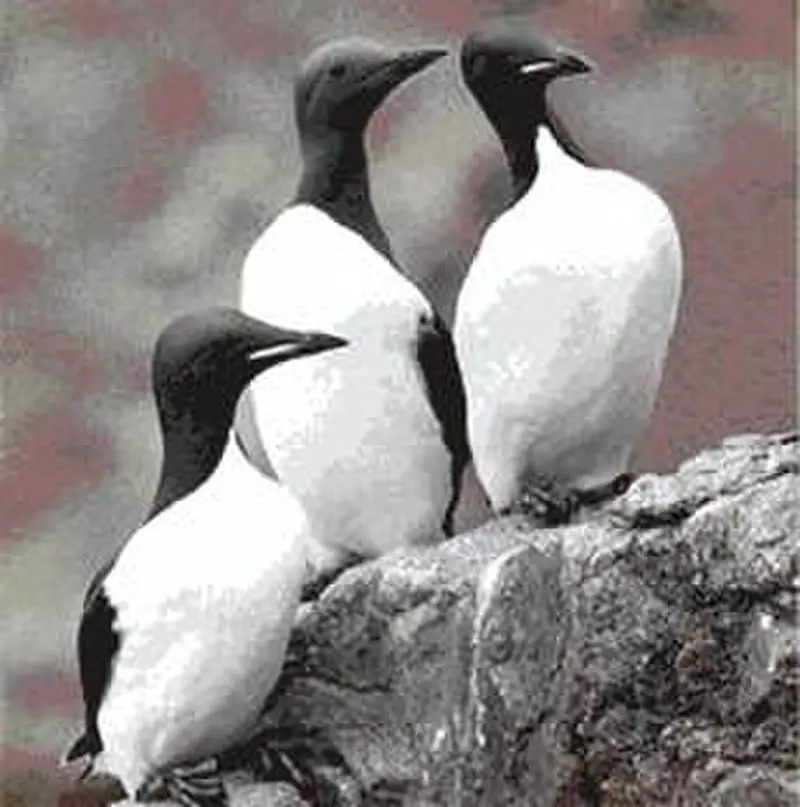
Guillemots, also known as murres or turr, are seabirds belonging to the genus Uria. They have brown or black plumage during breeding season and are medium-sized.
These birds breed on the coasts of the northern Atlantic and Pacific oceans. The name “guillemot” is commonly used in Britain.
The French zoologist Mathurin Jacques Brisson introduced the genus Uria in 1760.
Guillemots are known for their ability to dive deep in search of fish, their primary food source.
They are also known for their unique calls, which are used to communicate with their mates and offspring.
Overall, guillemots are fascinating birds that are an important part of marine ecosystems.Scientific classification:
| Kingdom | Animalia |
| Phylum | Chordata |
| Class | Aves |
| Order | Charadriiformes |
| Family | Alcidae |
| Genus | Uria Brisson, 1760 |
Also Featured In: Common Birds Found in Wrangel Island,
45. Gannets
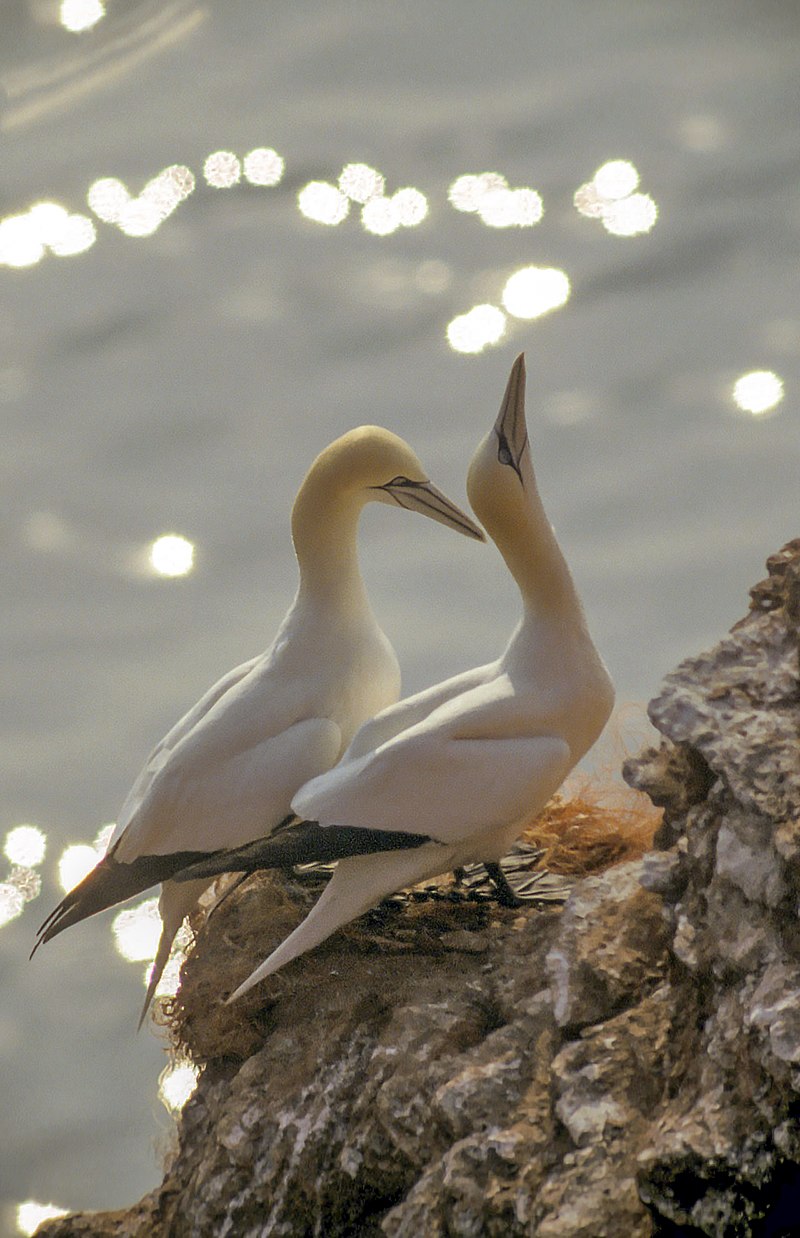
Gannets are marine birds that belong to the family Sulidae and are closely related to boobies. These large white birds have black-tipped wings, yellowish heads, and long bills.
With a wingspan of up to 6 1/2 feet, Northern gannets are the largest seabirds in the North Atlantic.
There are three species of gannets, with the other two found in the temperate seas of southern Africa and southern Australia.
Gannets are known for their spectacular diving abilities, plunging into the water at high speeds to catch fish.
They are also social birds, nesting in large colonies where they engage in courtship displays and territorial behaviors.
Overall, gannets are fascinating and impressive birds that play an important role in the marine ecosystem.Scientific classification:
| Kingdom | Animalia |
| Phylum | Chordata |
| Class | Aves |
| Order | Suliformes |
| Family | Sulidae |
| Genus | Morus Vieillot, 1816 |
Also Featured In: Common Cornwall Birds, Birds that Live in Faroe Islands
46. Kittiwakes
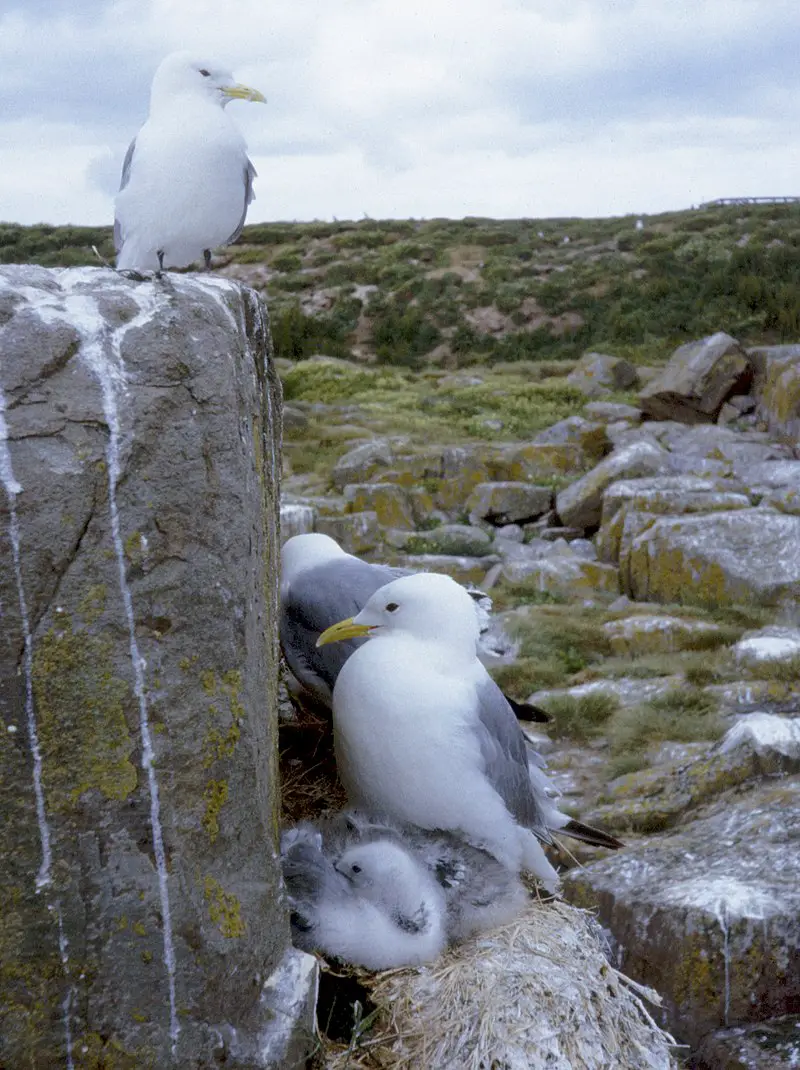
Kittiwakes are part of the gull family and there are two species, the black-legged and red-legged. They are distinguishable in North America, but in Europe, only the black-legged species is found.
They predominantly live near the coast and feed on small fish and other marine creatures. These birds are well adapted to life at sea and can glide over vast distances with minimal flapping of their wings.
Breeding colonies are found in rocky areas, where they build nests made of grass and feathers.
Unfortunately, kittiwake populations have been declining due to factors such as climate change, overfishing, and pollution.
Conservation efforts are being made to protect these birds and their habitats.Scientific classification:
| Kingdom | Animalia |
| Phylum | Chordata |
| Class | Aves |
| Order | Charadriiformes |
| Family | Laridae |
| Subfamily | Larinae |
| Genus | Rissa Stephens, 1826 |
Also Featured In: Birds of Farne Islands, Feathered Wonders of the Farne Islands: A Bird Watcher’s Paradise
47. Brown Pelican

The majestic brown pelican is a dive-feeding bird that belongs to the pelican family. It is one of the three pelican species found in the Americas and is known to dive into water to catch its prey.
From the Atlantic Coast of New Jersey to the mouth of the Amazon River, and along the Pacific Coast from British Columbia to northern Chile, including the Galapagos Islands, this bird can be found.
Its scientific name is Pelecanus occidentalis, and it has a colored brown plumage, which is its distinct characteristic.
The brown pelican belongs to the largest bird species that exist today, with a wingspan that can stretch up to seven feet long.
This bird helps maintain a balance in the ecosystem by eating smaller fish, crustaceans, and other aquatic prey.Scientific classification:
| Kingdom | Animalia |
| Phylum | Chordata |
| Class | Aves |
| Order | Pelecaniformes |
| Family | Pelecanidae |
| Genus | Pelecanus |
| Species | P. occidentalis |
Also Featured In: Flight Birds You Should Know, Common Southern Californian Birds
48. Aethia
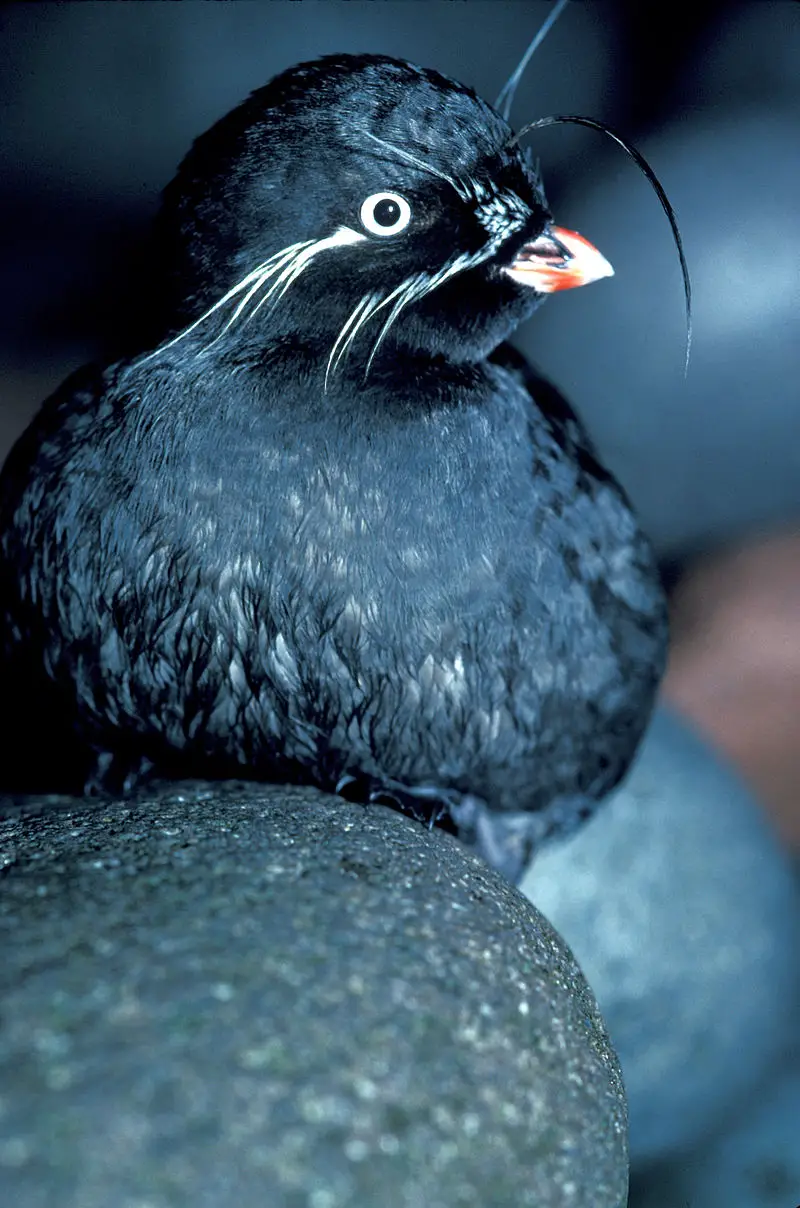
The Aethia bird genus consists of four small species that can be found in the North Pacific Ocean, Bering Sea, and Sea of Okhotsk.
These auklets are prized for their cuteness and are considered some of the most common seabirds in North America.
Unfortunately, the exact relationships between the four true auklets are still unknown. As much as these birds are loved, they are threatened by the presence of invasive species such as Arctic foxes and Norway rats.
These animals have a tendency to prey on birds, and Aethia birds are high on their list due to their colonial nature.
The Aethia bird is quite small, ranging from 85 to 300g, and is a joy to watch in its natural habitat.
Efforts are being made to protect the Aethia bird and ensure that these beautiful creatures can continue to thrive in their native environments.Scientific classification:
| Kingdom | Animalia |
| Phylum | Chordata |
| Class | Aves |
| Order | Charadriiformes |
| Family | Alcidae |
| Tribe | Aethiini |
| Genus | Aethia Merrem, 1788 |
49. Sooty Shearwater
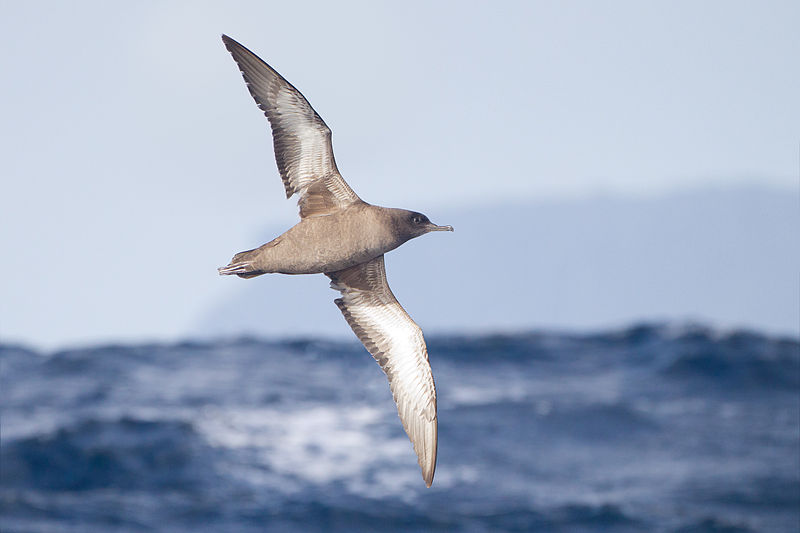
The sooty shearwater is a medium-large seabird in the Procellariidae family. It is also known as tītī in New Zealand and muttonbird, like its relatives.
Johann Friedrich formally described the bird in 1789.Scientific classification:
| Kingdom | Animalia |
| Phylum | Chordata |
| Class | Aves |
| Order | Procellariiformes |
| Family | Procellariidae |
| Genus | Ardenna |
| Species | A. grisea |
Also Featured In: Birds You’ll Find in Vancouver Island, Most Common Birds of Sierra Islands
50. Tropicbirds
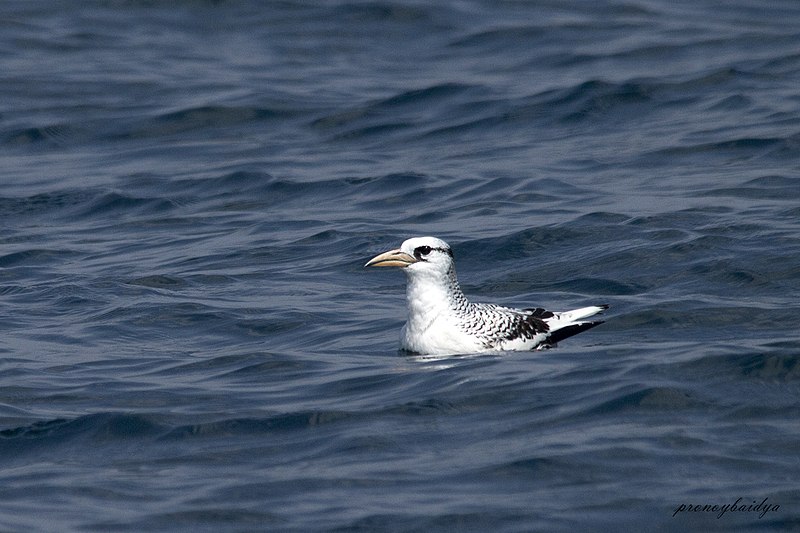
Tropicbirds are elegant and graceful seabirds found in tropical and subtropical waters around the world. They have distinctive long tail feathers that can reach up to 35 inches in length.
Tropicbirds have a white plumage with black markings on their wings and back, and their bills are long and curved.
They are excellent fliers and can stay airborne for hours, soaring effortlessly over the ocean.
Tropicbirds feed on fish and squid, which they catch by diving from the air. They breed in large colonies on remote islands, laying only one egg per year.
Tropicbirds are vulnerable to habitat loss and are threatened by human activities, such as pollution and disturbance of nesting sites.
Conservation efforts are essential to protect these magnificent birds and their habitats for future generations.
51. Flesh-Footed Shearwater
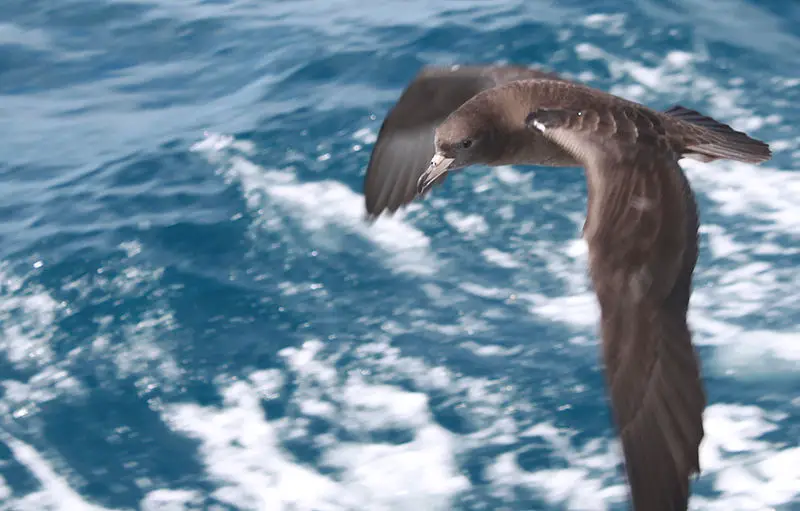
The Flesh-footed shearwater, also known as Ardenna carneipes, is a medium-sized bird with black plumage. It has pale pinkish feet and a pale bill with a distinct black tip.
The Flesh-footed shearwater is part of the Hemipuffinus group, alongside the pink-footed shearwater.
This group may or may not have a relative in the Atlantic called the great shearwater.
The Flesh-footed shearwater is a seabird that primarily feeds on fish and squid.
This species is known for its long-distance migration, as it travels from its breeding grounds in southern Australia to its feeding grounds in the eastern Pacific Ocean.
The Flesh-footed shearwater is vulnerable to multiple threats, including plastic pollution and bycatch in fishing gear.
Conservation efforts are underway to protect this species and its breeding colonies.Scientific classification:
| Kingdom | Animalia |
| Phylum | Chordata |
| Class | Aves |
| Order | Procellariiformes |
| Family | Procellariidae |
| Genus | Ardenna |
| Species | A. carneipes |